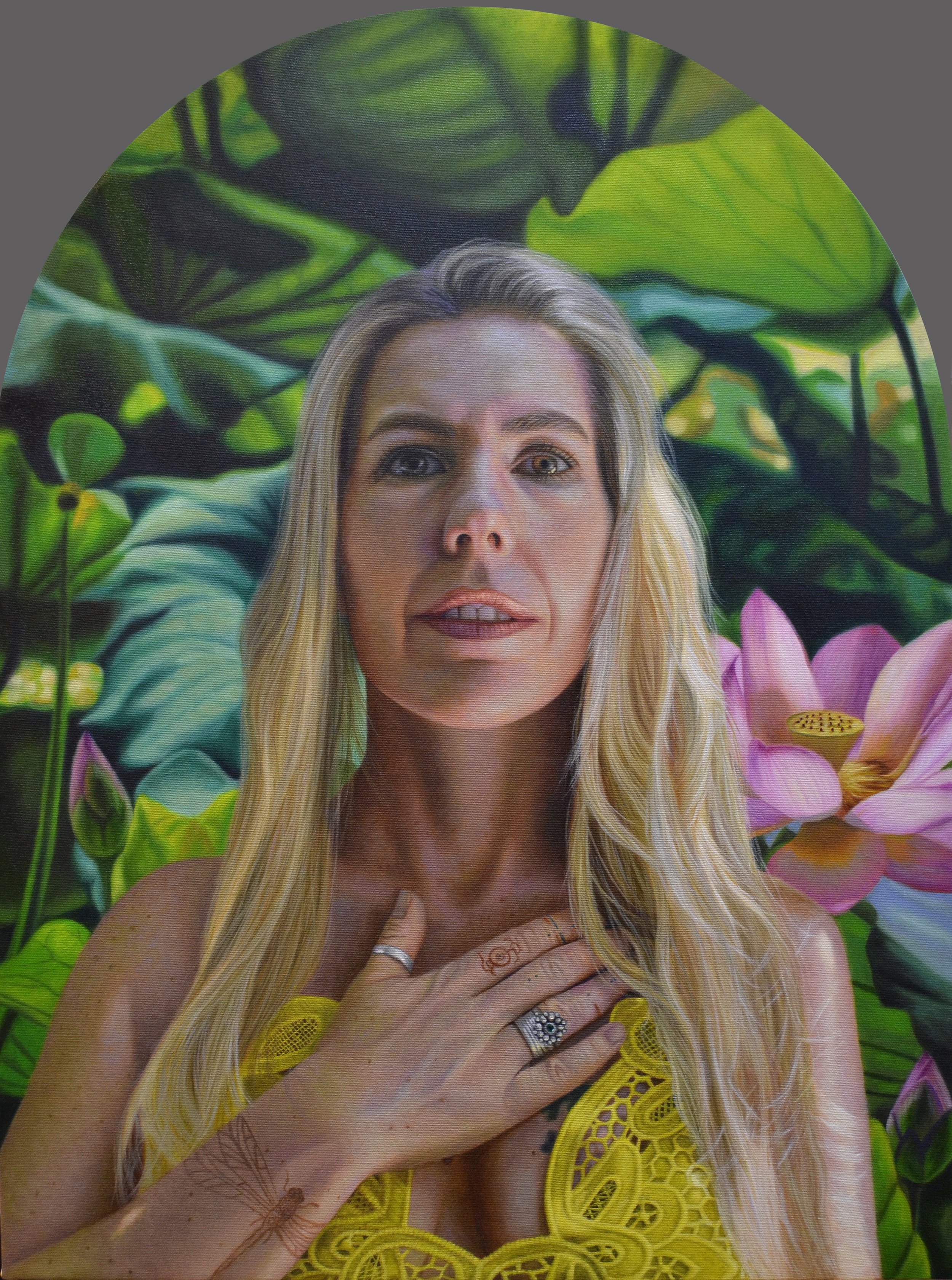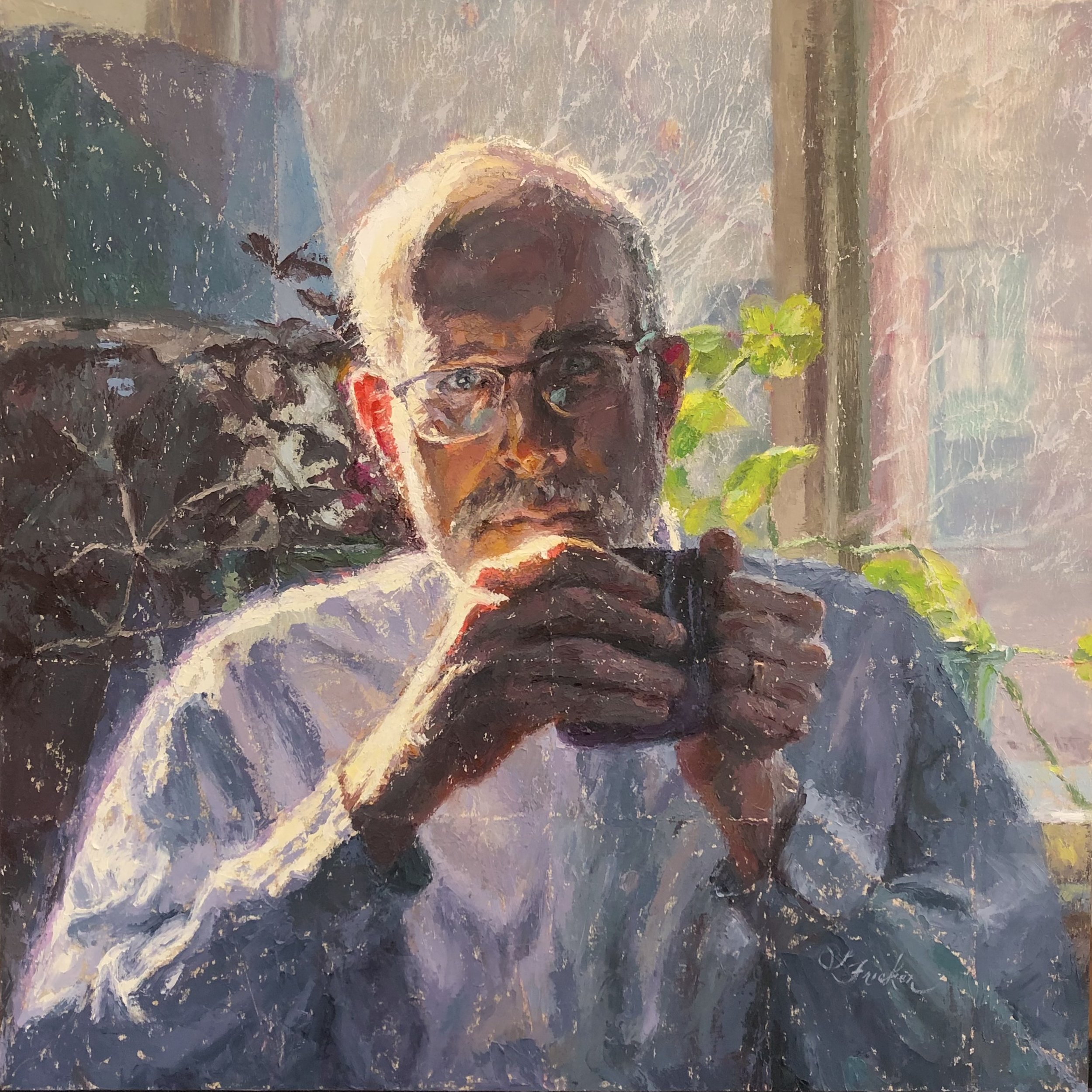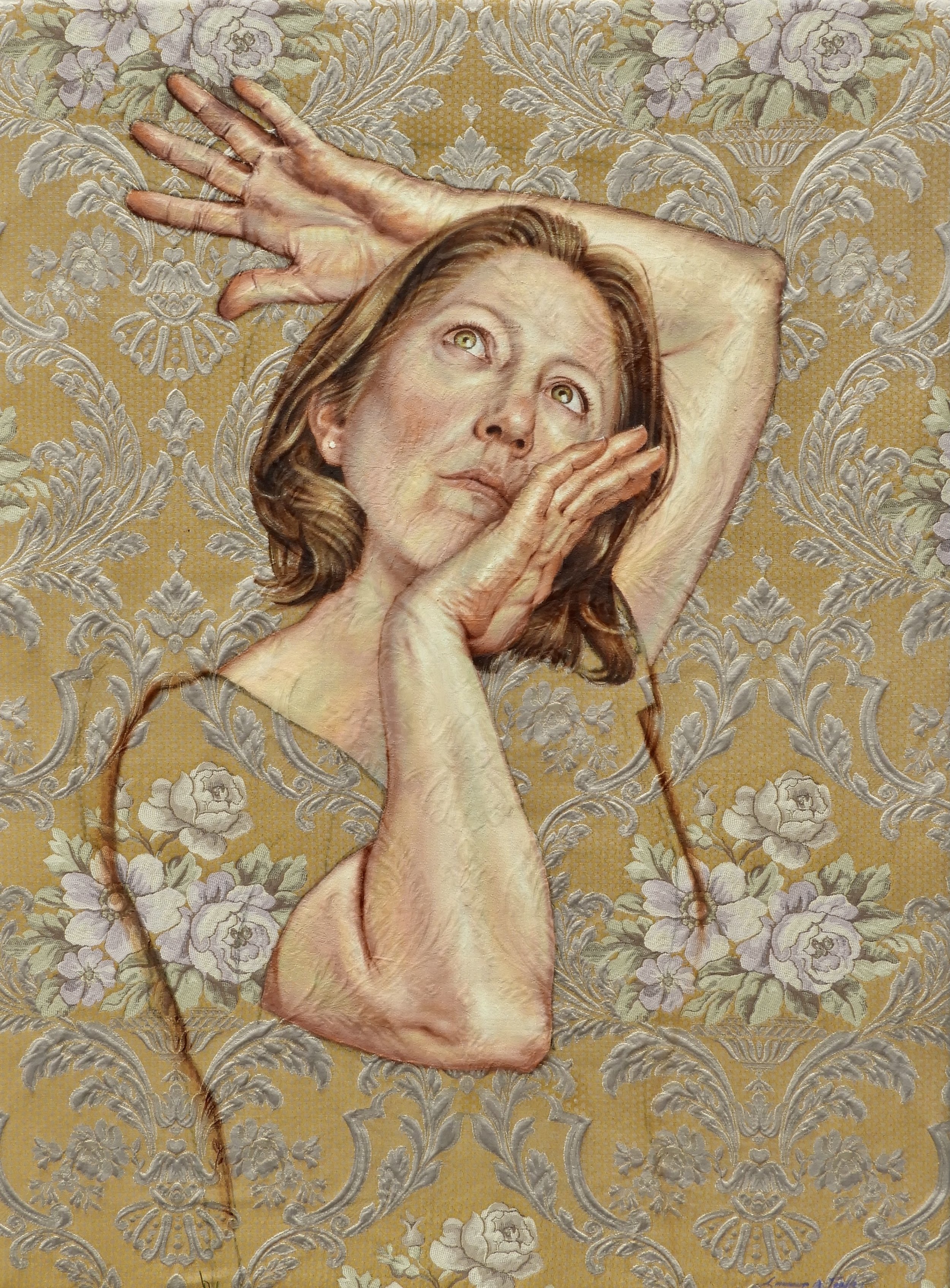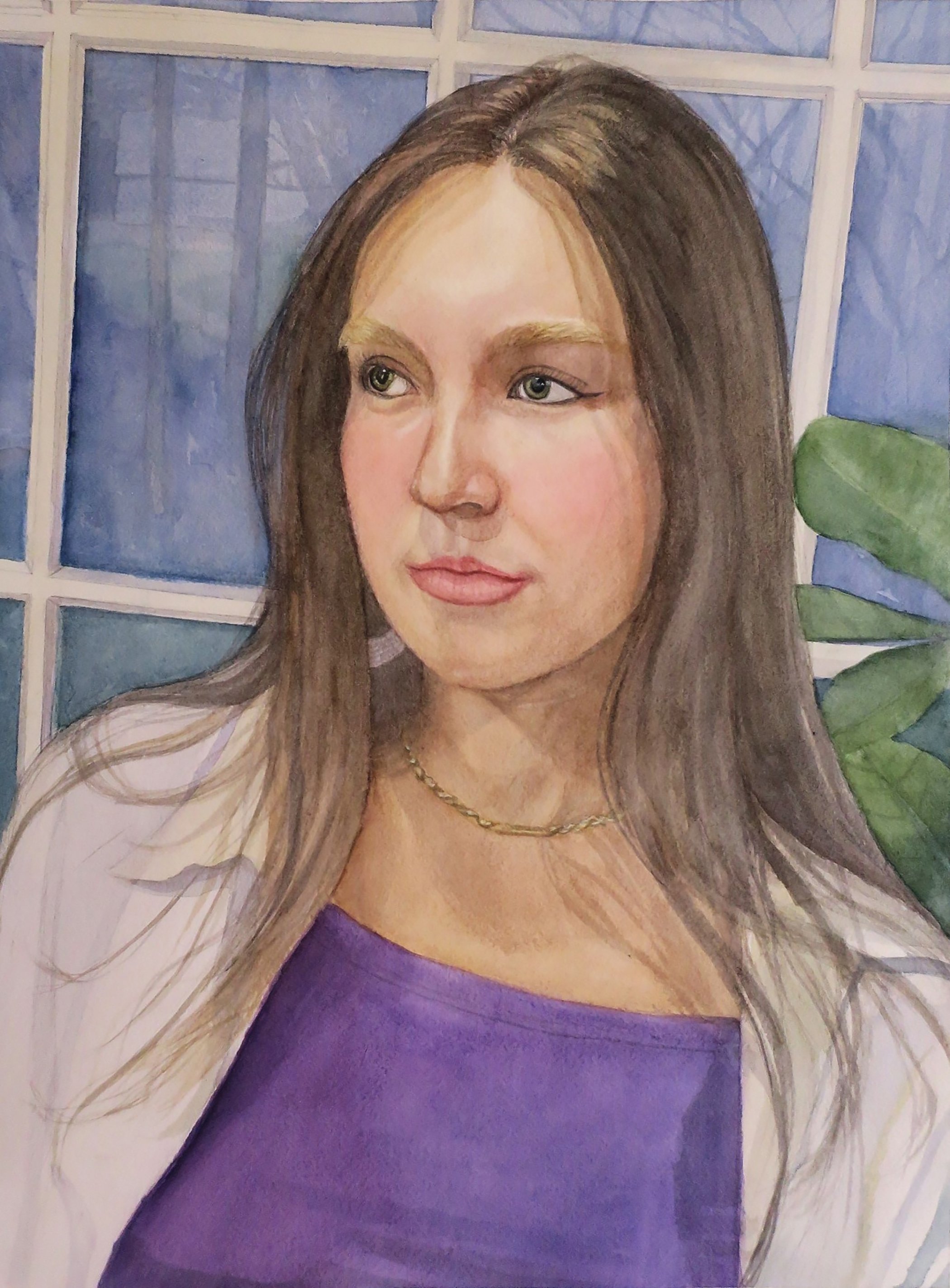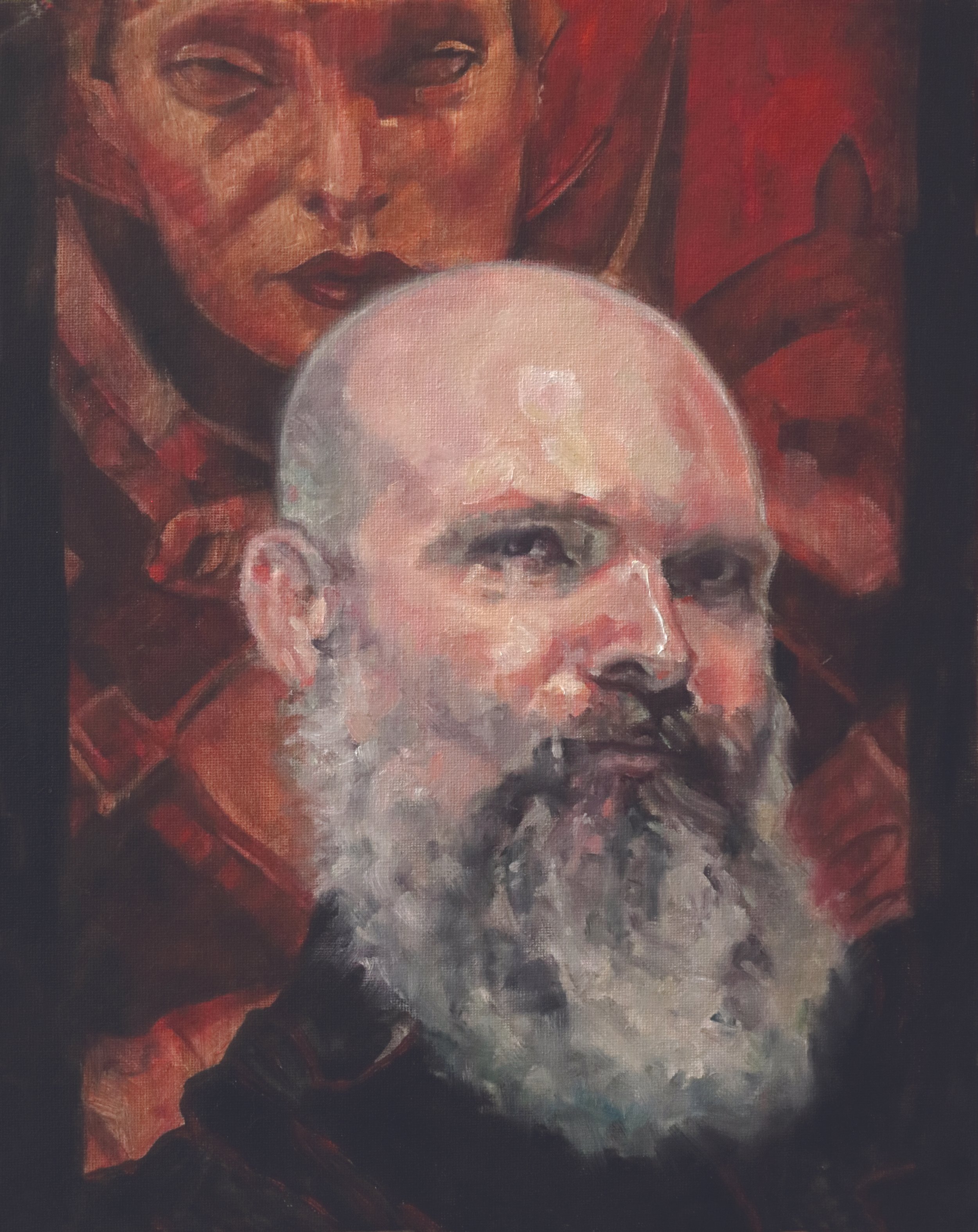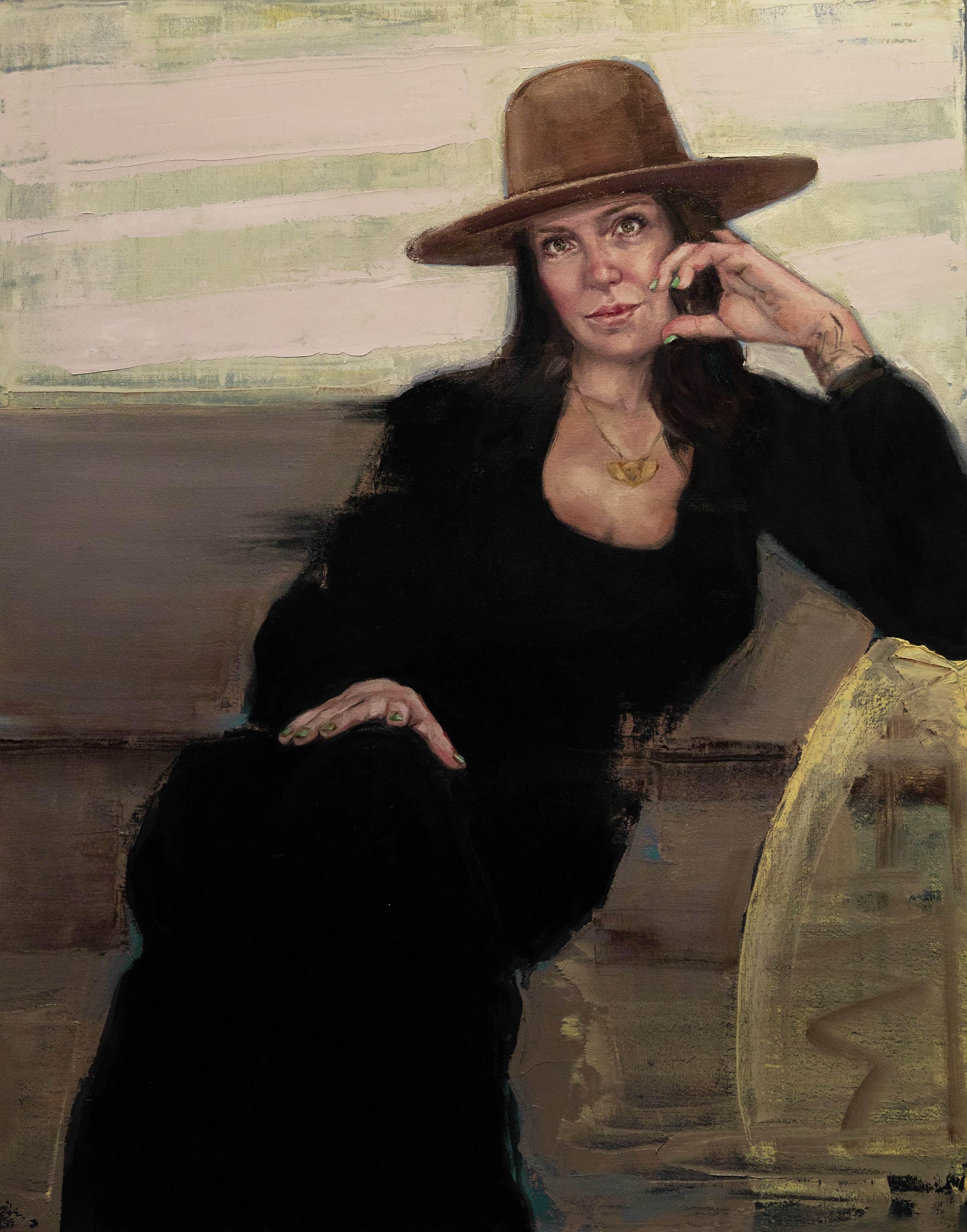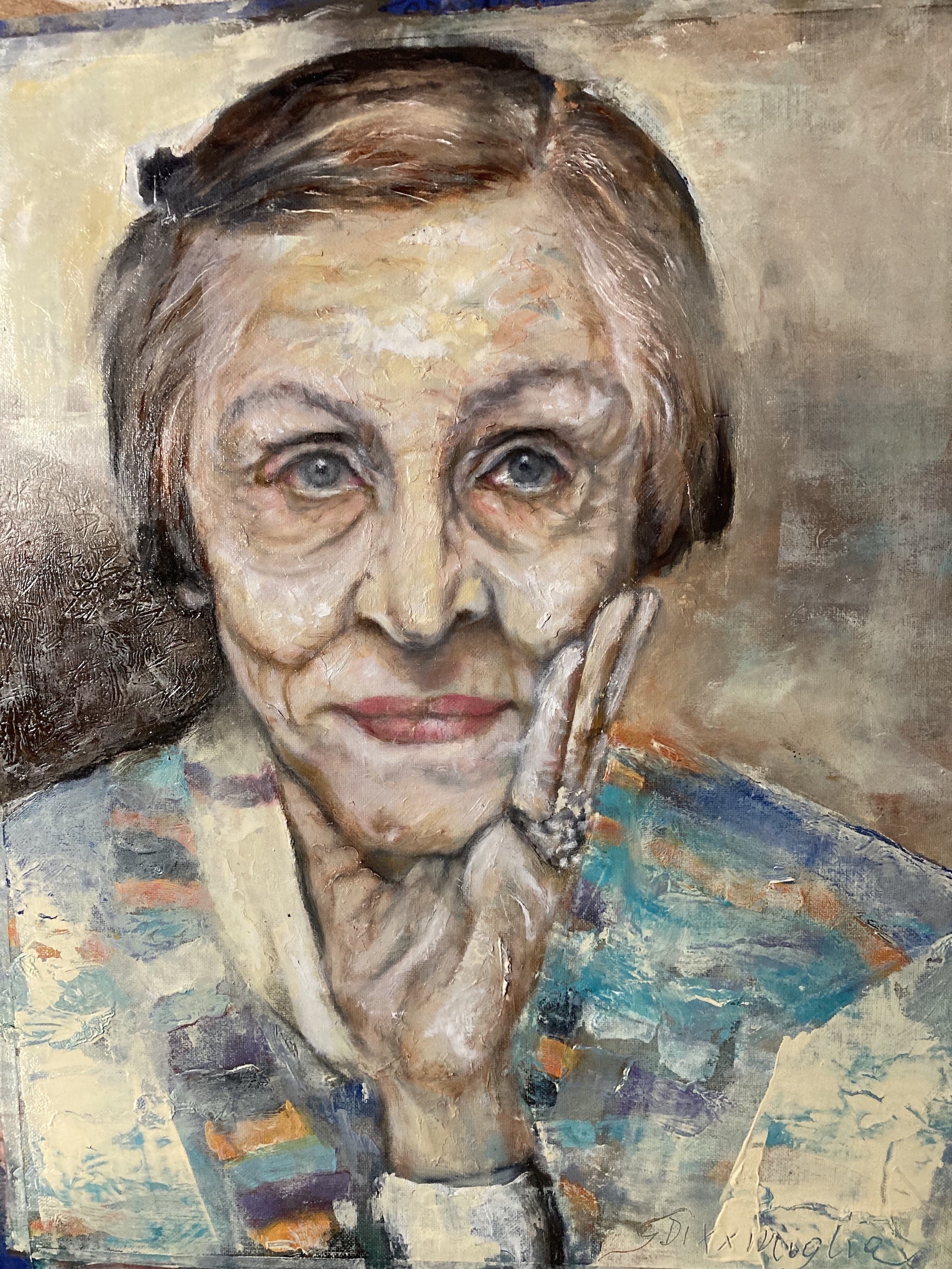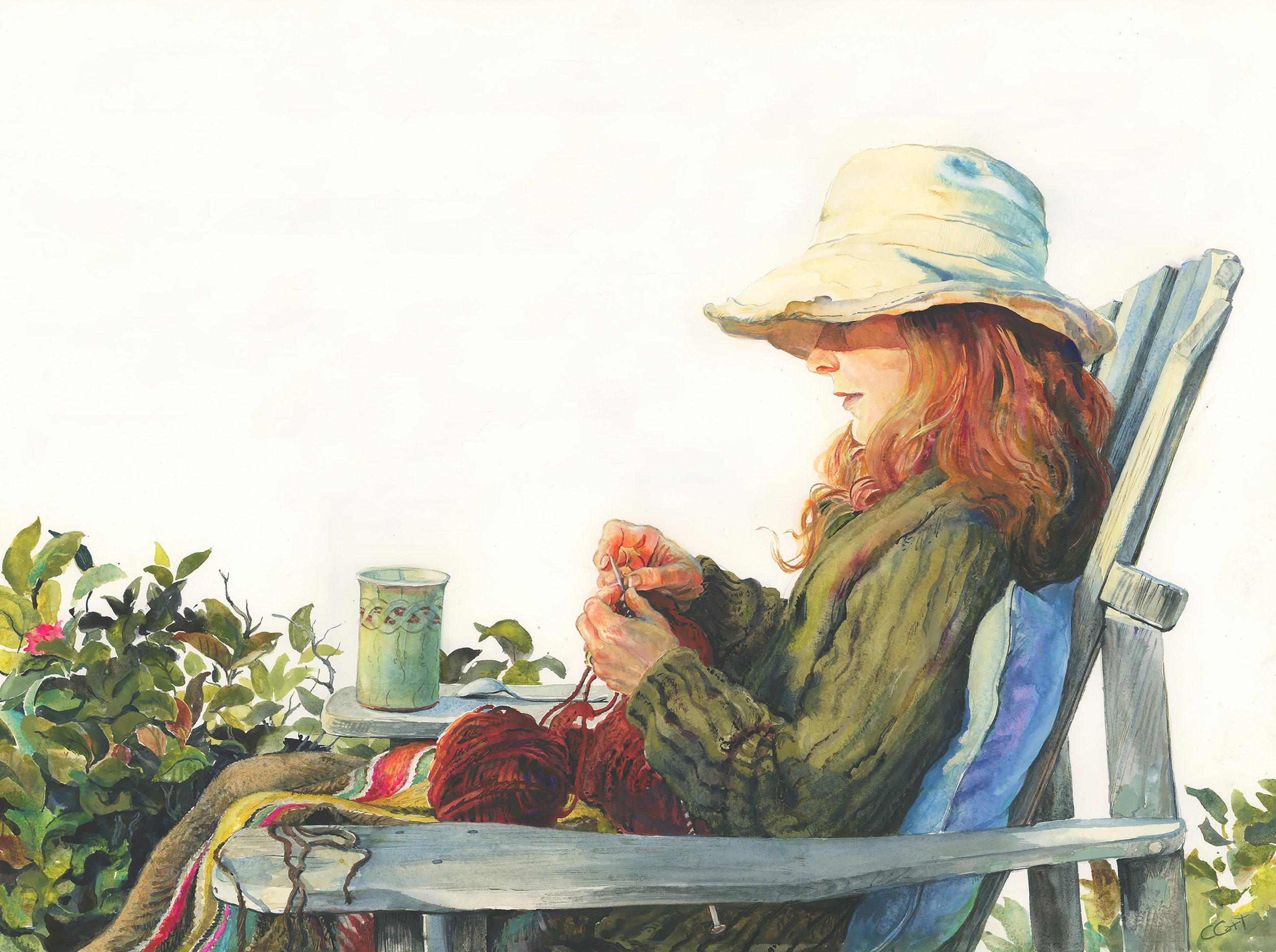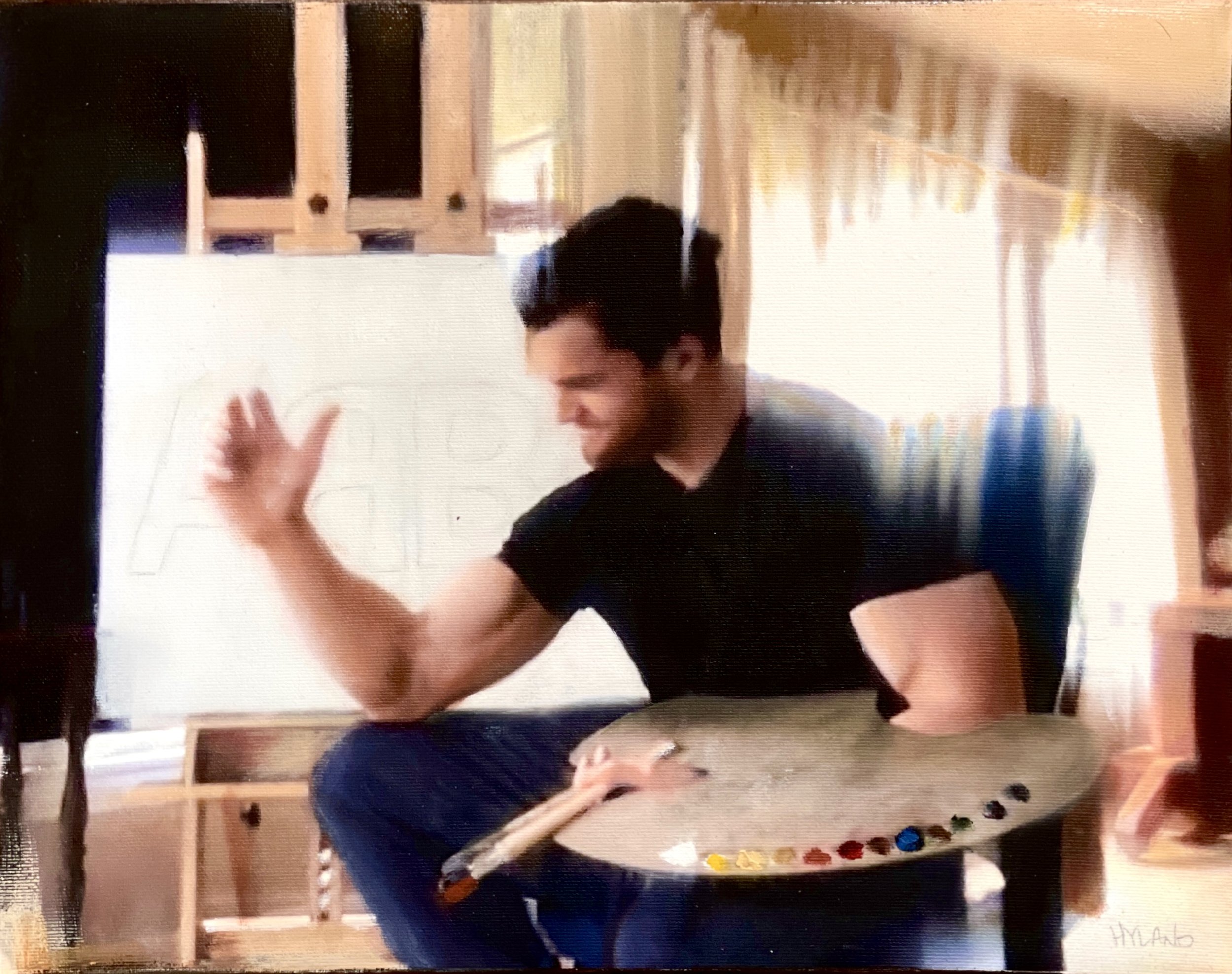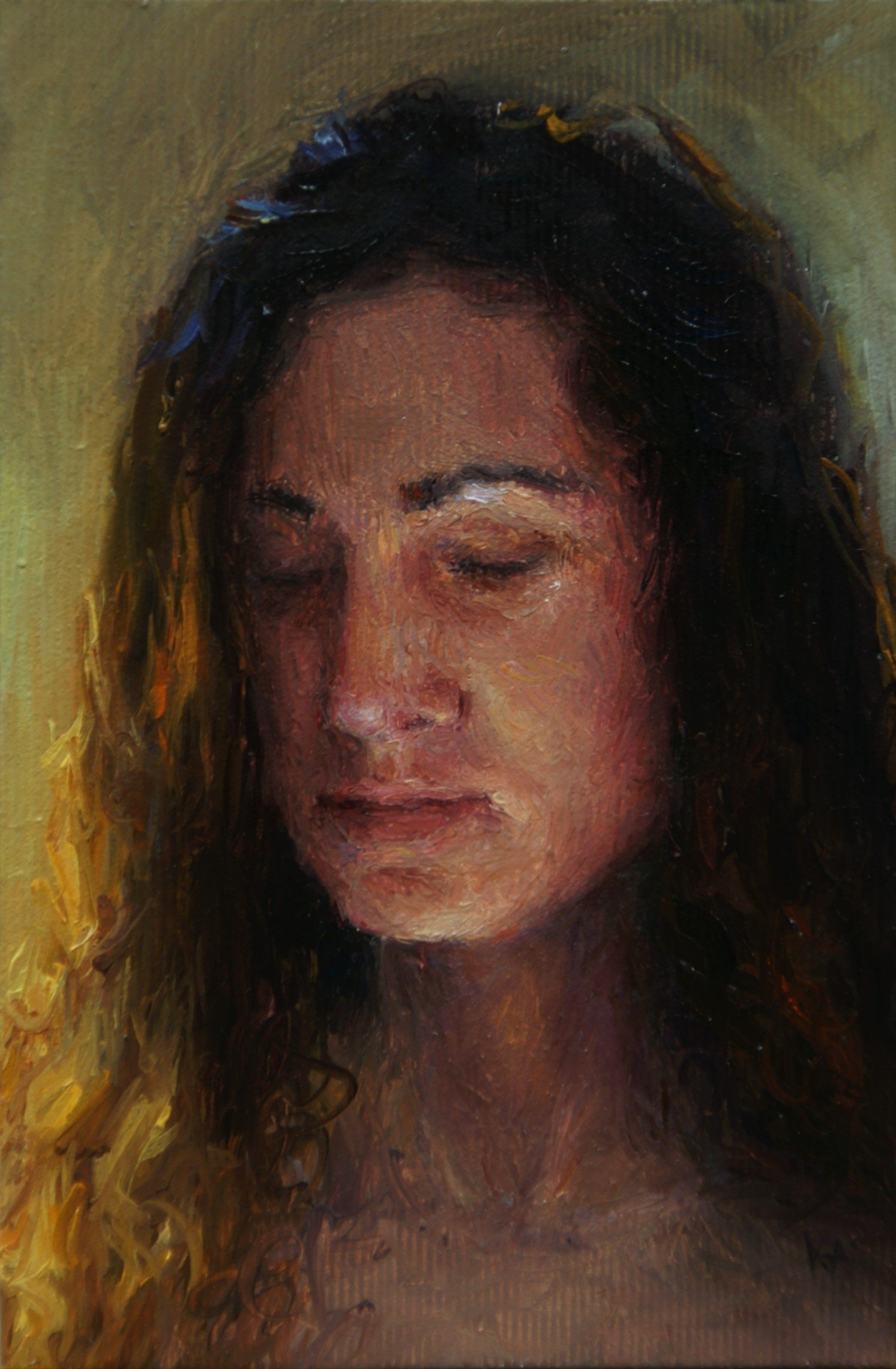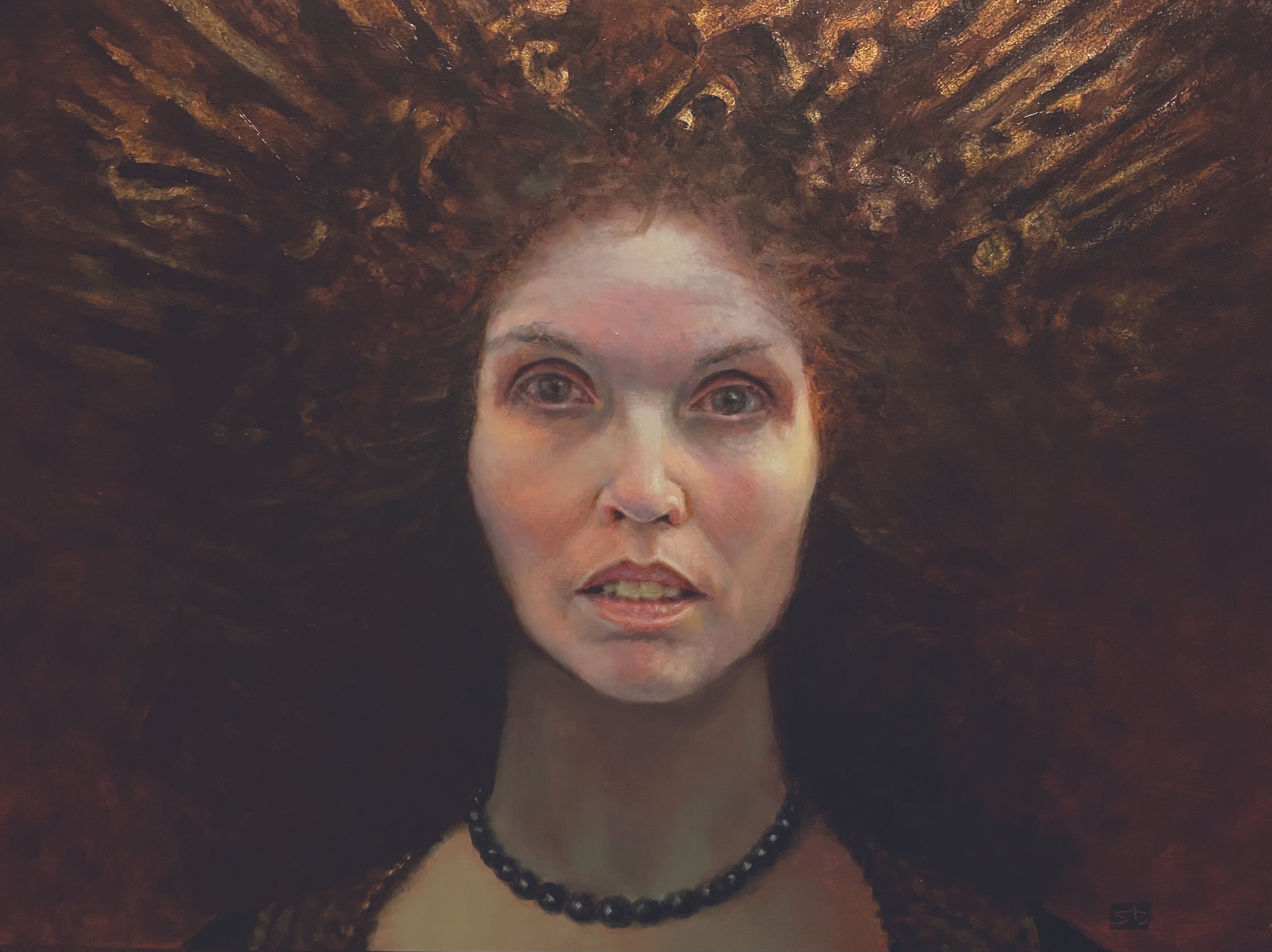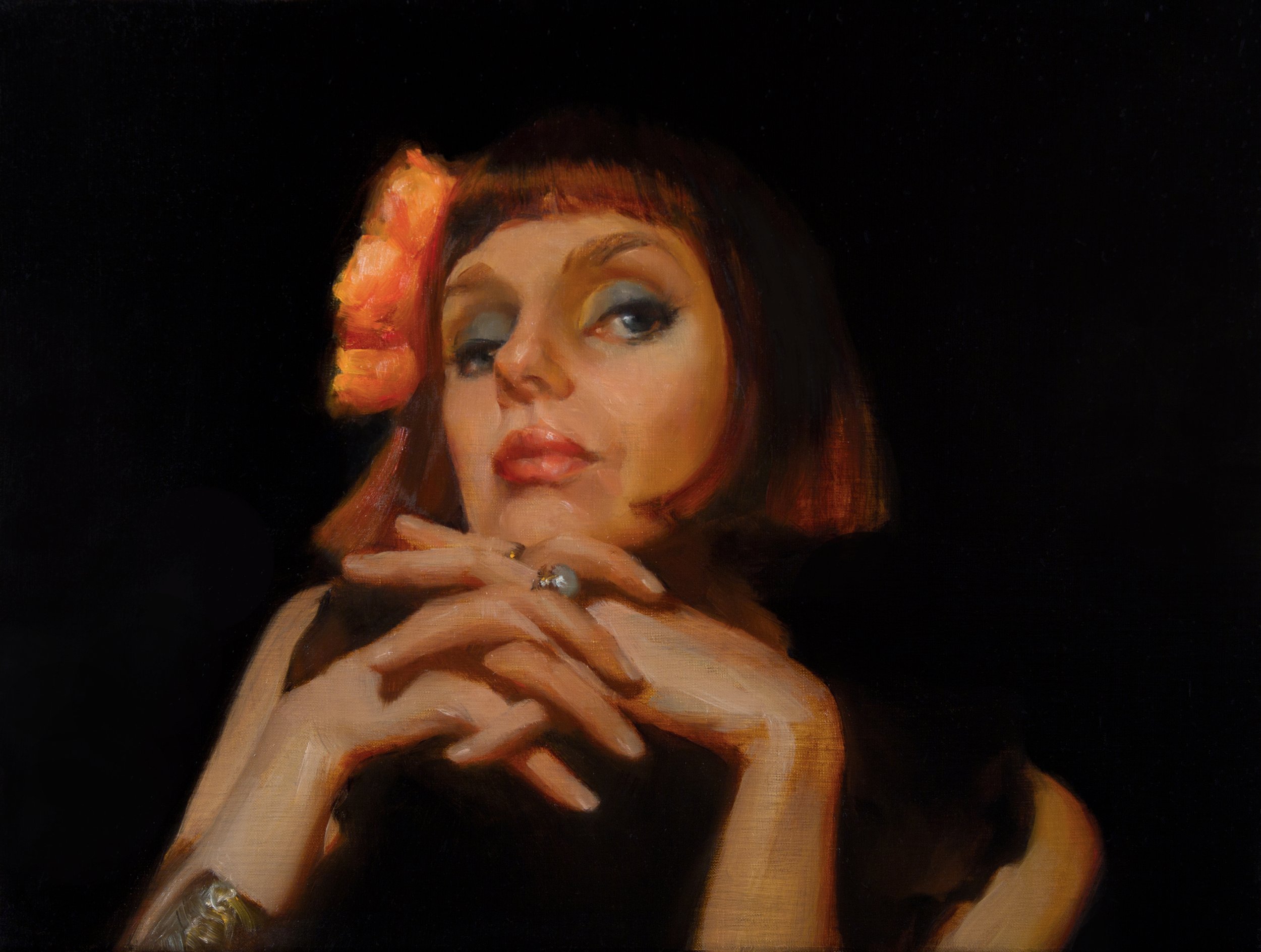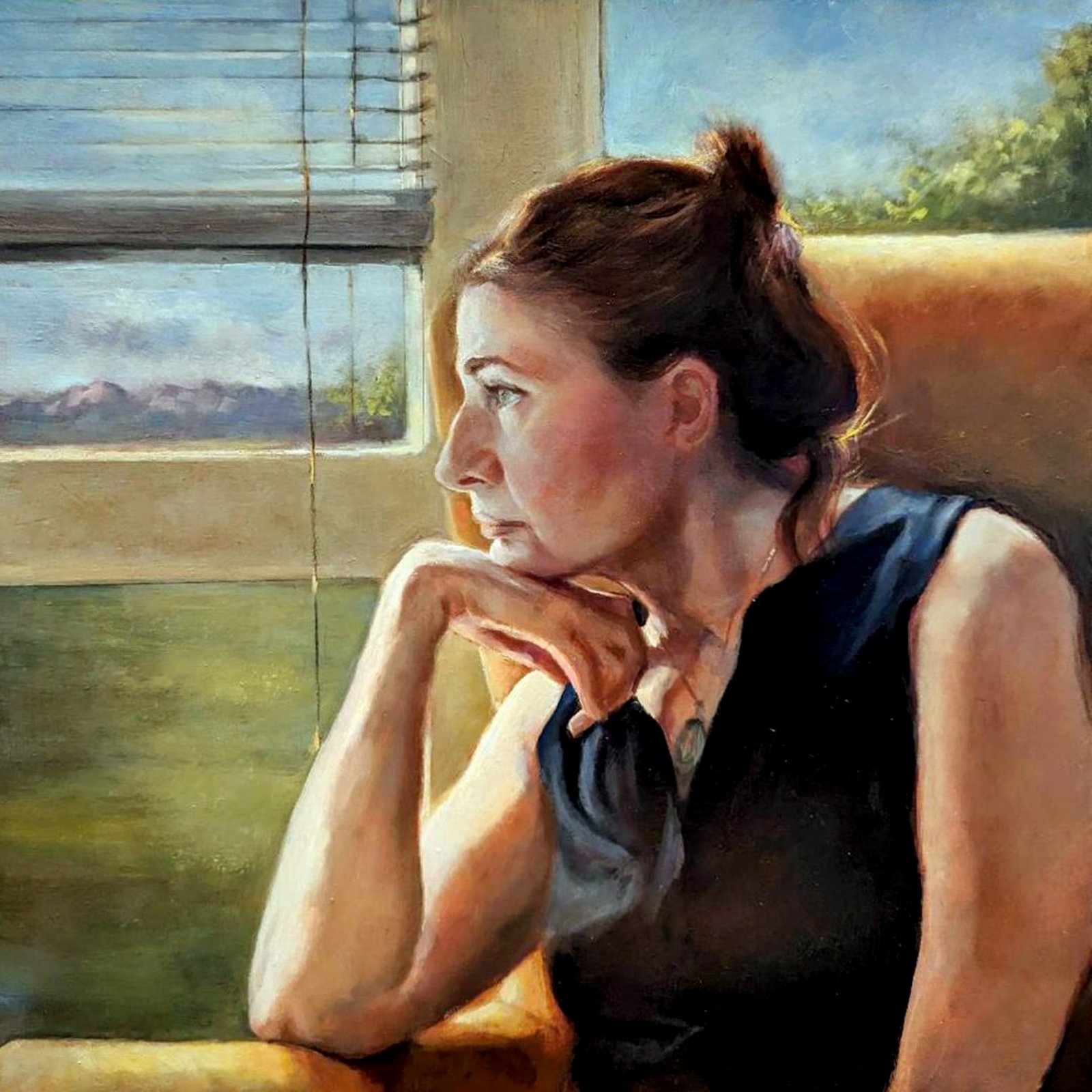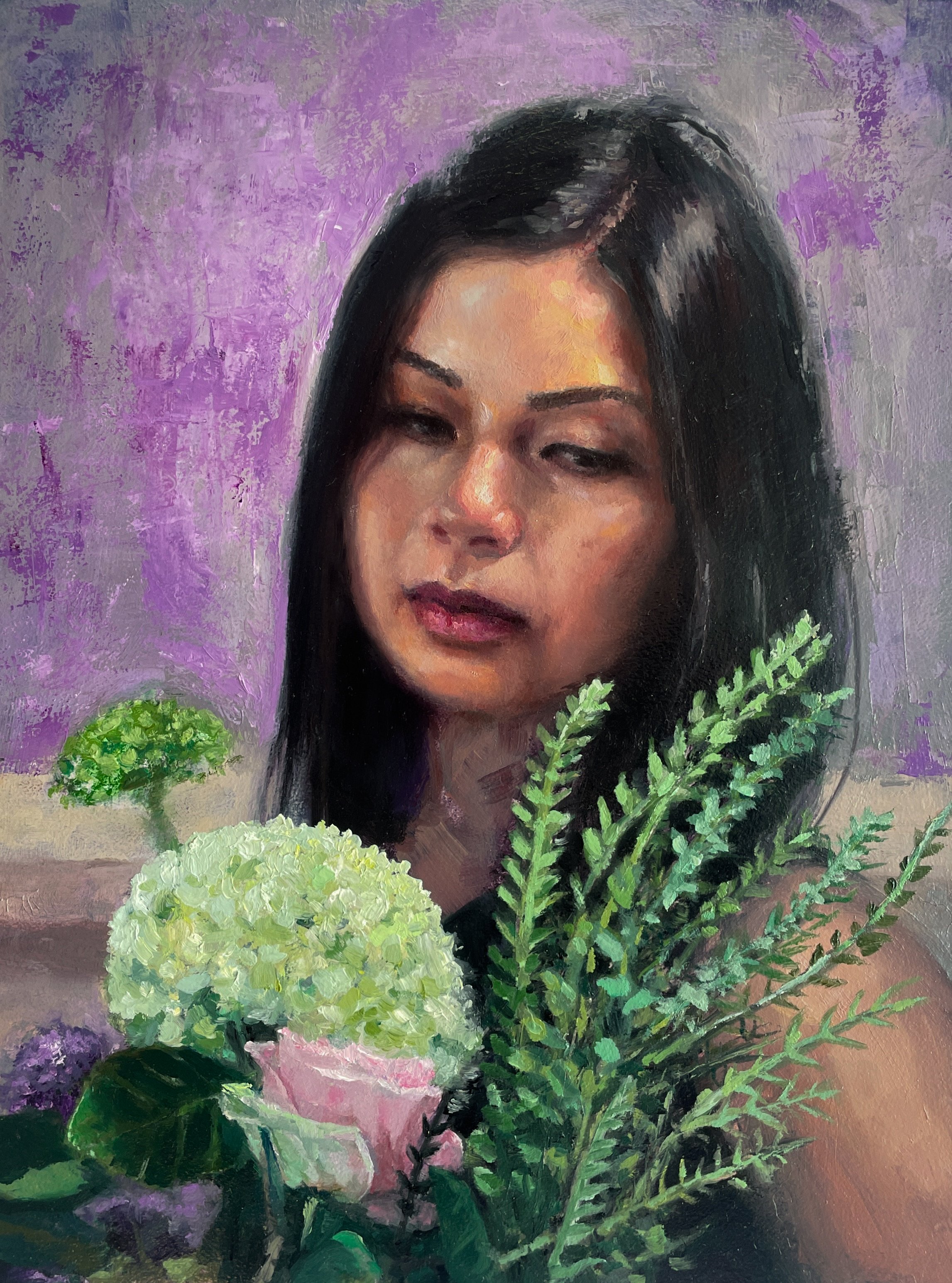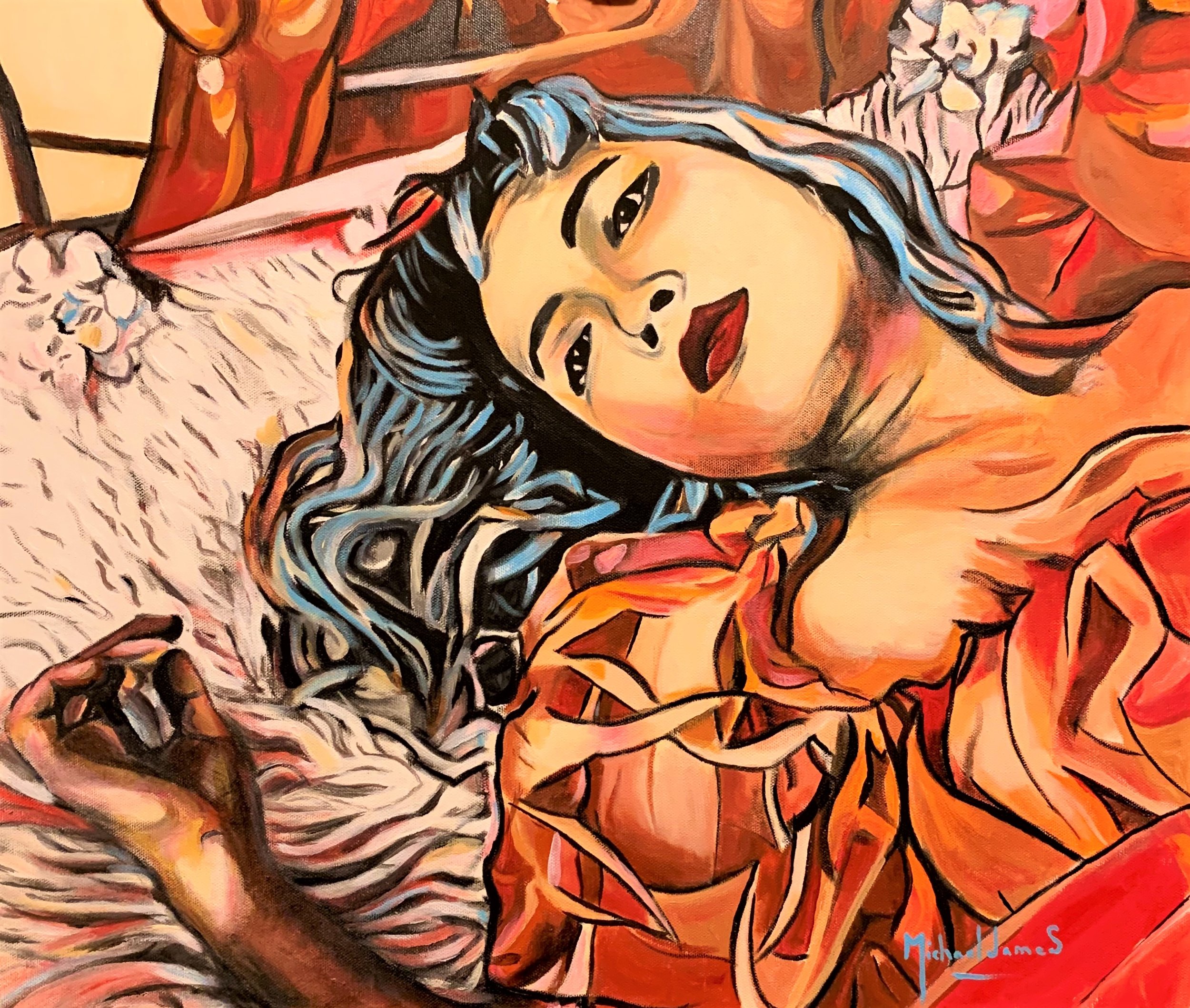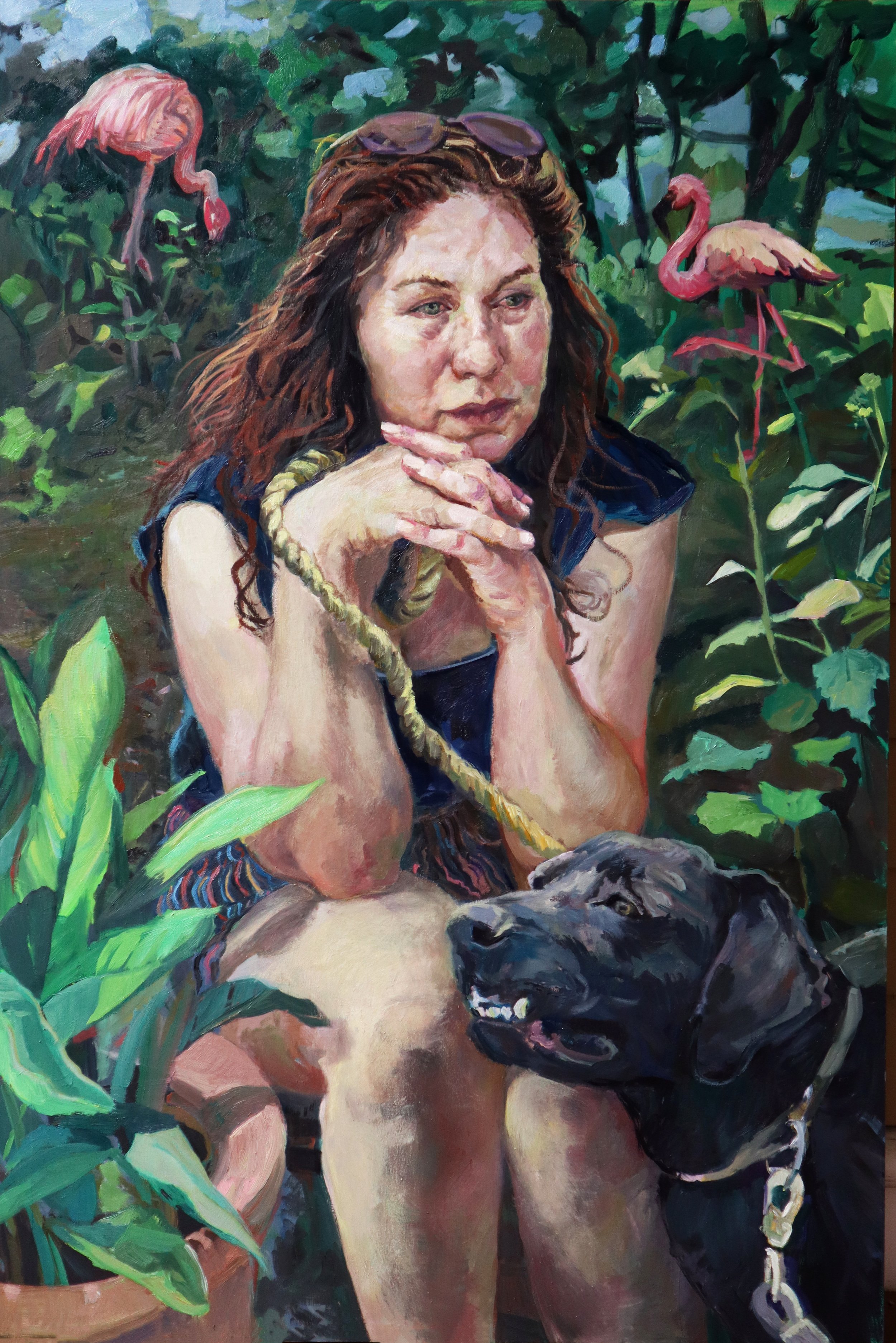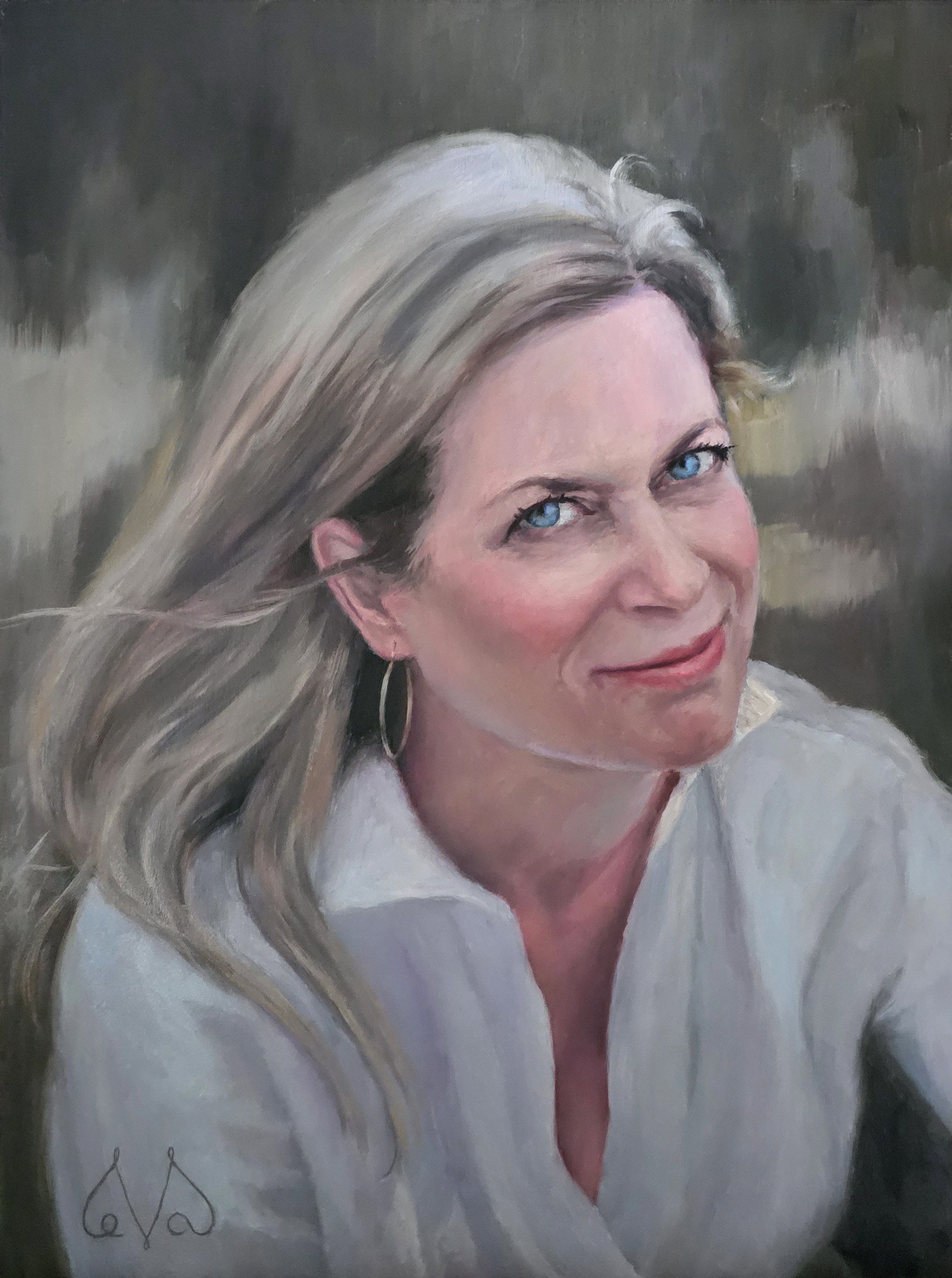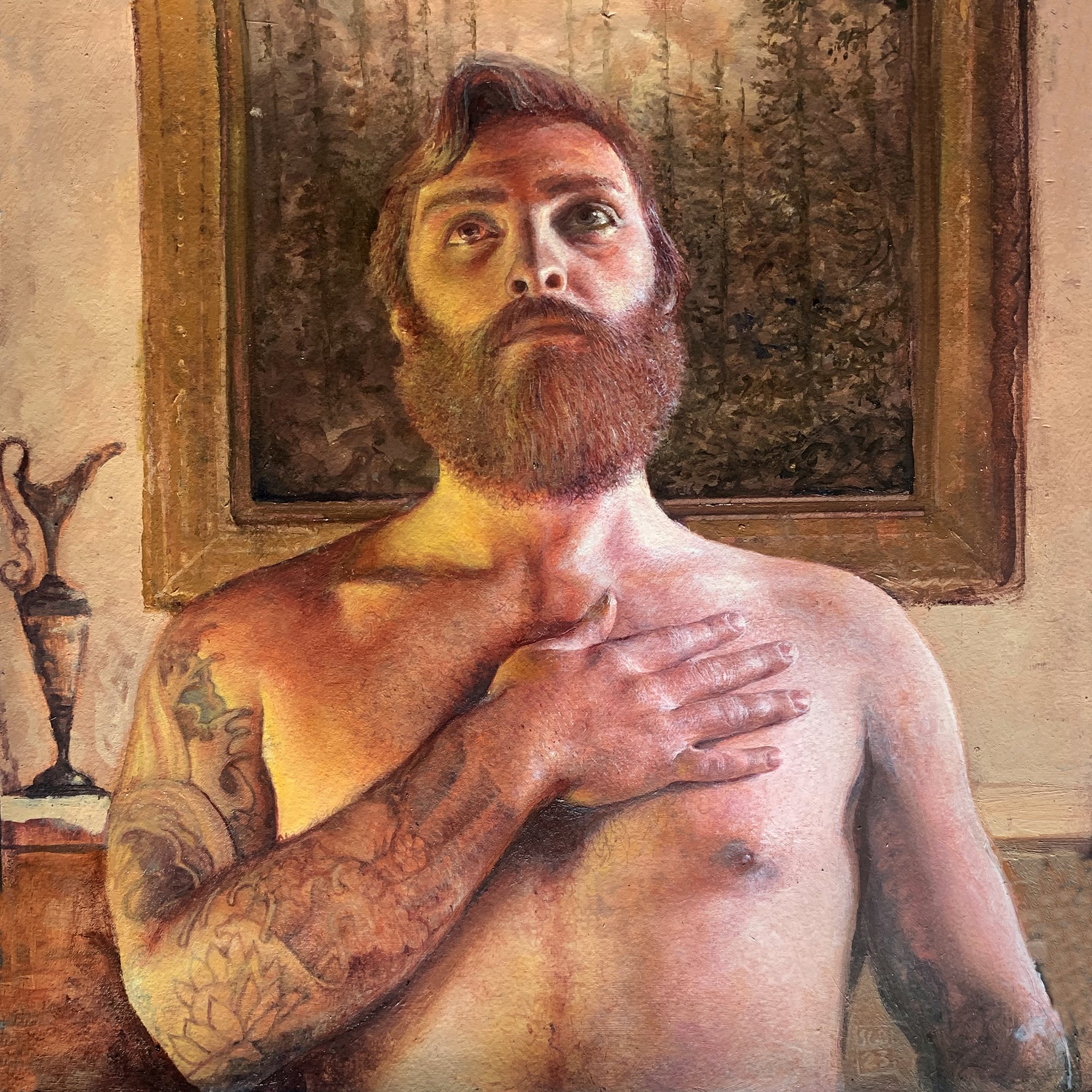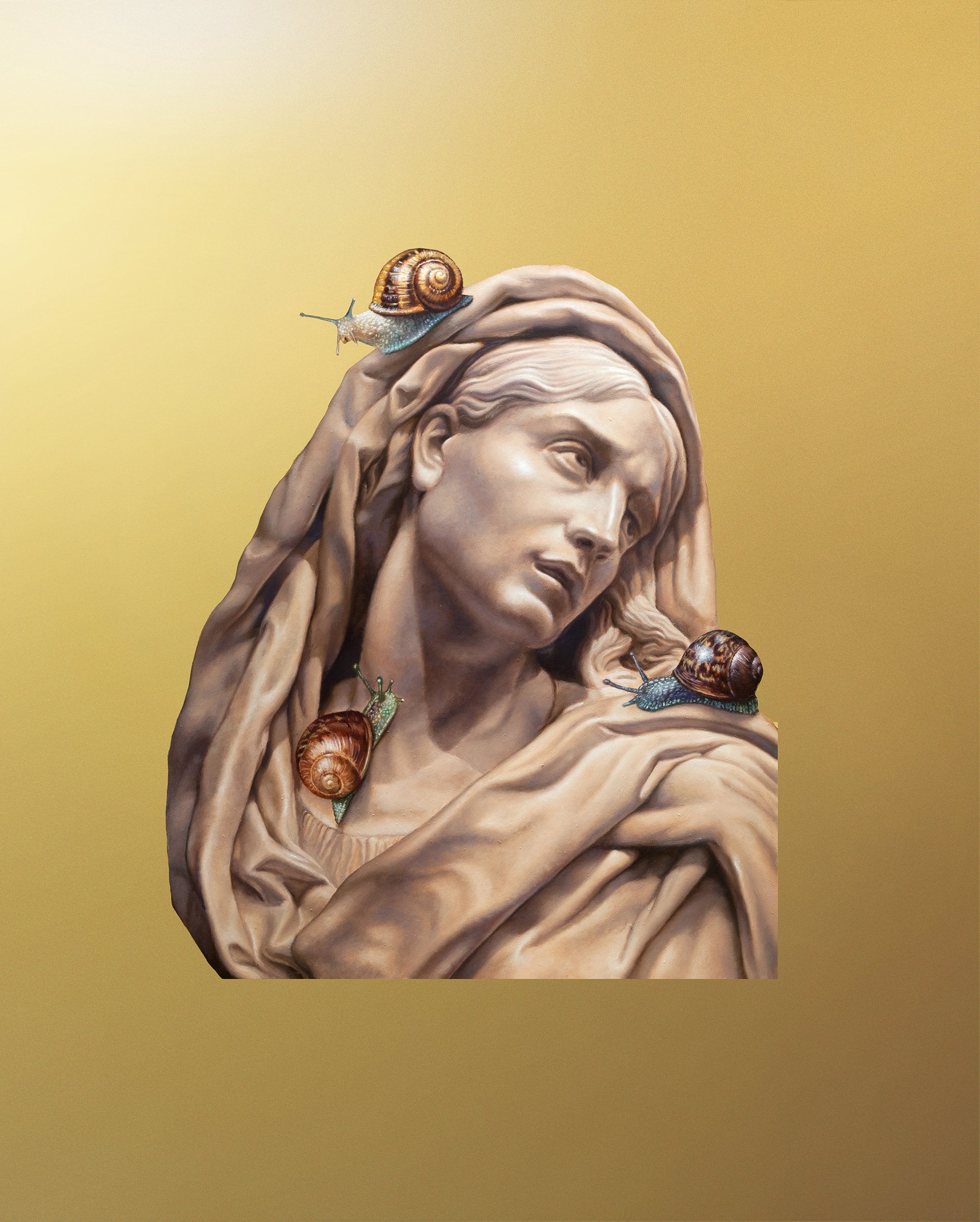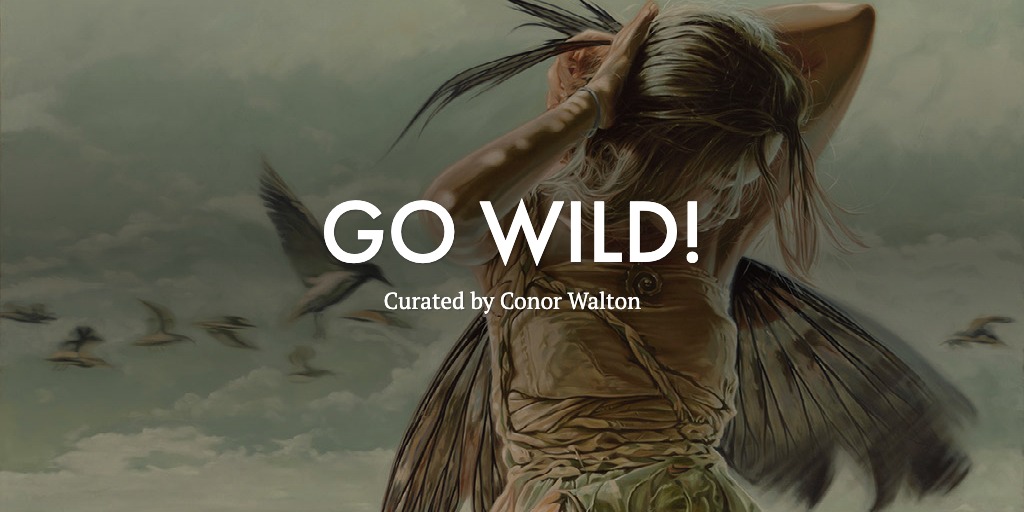O’Neil Scott is a Pennsylvania based representational oil painter. Captivated by portraiture and its capacity to impart complexities that comprise the human condition his work is designed to give a voice to marginalized communities. His paintings convey contemporary subject matter and look to give the viewer a way to understand and relate across social boundaries. He had his third solo show in 2022 and has been in numerous publications including Fine Art Connoisseur Magazine, American Art Collector Magazine, and Artist Magazine. His work is in private collections across the United States and Internationally. He currently has a solo exhibition planed for Villanova University in 2022 and a Solo Museum Exhibition at the Zillman Art Museum in 2025.
Kim Leutwyler | Painting the LGBQT Community
Born in America, Sydney-based Kim Leutwyler migrated to Australia in 2012. She works in a variety of media including painting, installation, ceramics, print media and drawing. Leutwyler's current body of work features paintings exploring notions of beauty, gender and queer identity. She has come to focus on painting as a medium because of its primarily masculine history in the western art canon. Her artwork has been exhibited in multiple galleries and museums throughout Australia and the United States.
Rachel Linnemeier | Complex Figures
Rachel Linnemeier’s subject matter includes powerful women in situations that both evoke strong feelings of nostalgia and inspire narratives. The overarching theme of Rachel’s work includes tension between the idea of modern adulthood and residual childhood. Each piece is composed of bright and vivid colors creating a youthful feeling while simultaneously expressing maturity through the pose and expression of the figure. Recent works have begun to explore the addition of landscapes to create complexity in narrative.
Add to your art collection @Artsy
Ann Moeller Steverson | The Emotive Figure
Ann Moeller Steverson is an American artist known for her emotive and mood filled figurative works, primarily created with oil on copper. Her works are described as having a timeless quality which invites the viewer to create their own sensitive response and narrative through a compelling tension and sense of mystery. Through the quiet intensity of each piece she seeks to share her most authentic self, what she loves, and an invitation for connection. Born in Huntsville, Al, in 1980 she continues to reside there, working within a vibrant artist community. There she paints, teaches, and operates an atelier to promote the advancement of realism in modern painting.
Pauline Aubey | LEGO Art
Paulina Aubey uses lego bricks to create portraits who question our relationship to cultural icons through an interplay between abstraction and realism. Inspired by stained glass, she now adds some luminous effects to her artwork using a superimposition of matte and transparent bricks that she calls glazing. She mainly focuses on intimate close-up portraits that remain undecipherable despite close inspection. Her body of work is an attempt at alleviating the inherent tension between technology and mysticism. She is part of the Lunar Codex and a judge for Lego Masters France.
Chris Clark | Hair Culture
Chris Clark is a self-taught visual artist, illustrator, and muralist living and working in Jacksonville, Florida. Art, to him, is a form of journalism.
Using acrylic, oil, ink, and spray paint, he explores the rich culture and history of the Black community across the diaspora and the social issues affecting them today. For Clark, reflecting the human figure is very powerful, which is why he uses graphic-style portraiture and figurative works to depict Black life in America through his personal lens of a Black man. At the core of his work is the notion that representation matters. As the artist explains, “By telling my story, I want to help the viewer rediscover theirs.”
Clark’s artwork has been shown in exhibitions around the U.S. and abroad, including his recent solo exhibition “New Growth” at Kent Gallery FSCJ in Jacksonville and at the Nelson Mandela Metropolitan Art Museum in Port Elizabeth, South Africa. He has received multiple art awards and grants for his work. Clark was chosen to participate in the House of Sedulo Artist Residency in London, UK and the Chateau Orquevaux Artist Residency in Champagne-Ardenne, France in 2022-2023. Most recently he completed his first artist fellowship the DEAR (Digital Evolution Artist Retention) fellowship through the Caribbean Cultural Center African Diaspora Institute in New York.
Amy Ordoveza
Amy Ordoveza is a contemporary realist artist who creates detailed, imaginative still-life paintings. She carefully crafts and arranges the delicate cut-paper plants, animals, and architectural elements that she depicts in her oil paintings. The fragility of the paper objects suggests impermanence while Ordoveza’s close observation and meticulous handling of paint hint at their significance. Her compositions evoke a sense of beauty and mystery in ordinary surroundings.
Ordoveza received her MFA from the New York Academy of Art and her BFA from the Maryland Institute College of Art. Her historical influences include 17th century Dutch still life painters including Rachel Ruysch and Jan Davidsz de Heem as well as surrealists such as Kay Sage and René Magritte. Ordoveza’s work is included in the Lunar Codex and the Nova Scotia Art Bank and has been featured in publications and websites including American Art Collector, PoetsArtists, and Booooooom!
Artists Painting Artists | A Window into Creative Souls →
Diana Carolina Lopez | Kate’s Resilience, 2023 | Oil on canvas | 31 9/10 × 23 9/10 in | 81 × 60.8 cm
In the realm of painting, there's a profound beauty in artists painting their peers. This practice is more than just a mere portrayal; it's a tribute, an intimate dialogue between creatives who share a relentless impulse to express. The online exhibition "Artists Painting Artists" magnificently en- capsulates this concept, offering viewers a chance to witness one artist's perspective of another's essence.
Imagine a world where each brushstroke is an ode, where every color and line is a symbol of respect for a fellow artist's journey. In this unique form of portraiture, the artist is both a narrator and a participant, engaging in an unspoken conversation with their subject. It's akin to self-portraiture, yet here, the artist sees themselves through the eyes of another, providing an external viewpoint that is often enlightening.
The exhibition leads us through various narratives, each portrait unfolding a story that beckons us to explore deeper. There's a certain magic in the gaze captured by these artists. It invites us to ponder, to lose ourselves
in the depths of the subject's character. What lies behind those eyes? What stories do they tell? These are questions that resonate throughout the gallery.
Historically, the art world is rich with examples of artists painting their contemporaries. These portraits are not just mere records; they are tes- taments, eternalizing the honor and reverence of being the subject of a fellow artist's canvas. They forge a bond across time, connecting the past, present, and future in a continuous thread of artistic admiration.
As you delve into this exhibition, let each portrait intrigue you, drawing you into the narratives they weave. Each piece is a journey into the heart of creativity, a celebration of the artistic spirit that connects us all. This is not just an exhibition; it's a homage to the enduring bond between artists, a tribute to the shared passion that fuels their creative souls.
- Sergio Gomez, MFA
Erica Calardo
Erica Calardo is a figurative painter living and working in Italy. Her works in oils, watercolors, and pencils are windows on the solitude of lost souls. She explores the realm of Beauty, Grotesque, and Magic, by creating eery oneiric feminine figures who tell tales of long forgotten dreams, of an imaginary timeless past.
Deeply rooted in the Italian Tradition, her technique is inspired by the Renaissance and Mannerism old masters (Leonardo, Bronzino, and Lavinia Fontana above all). She is mostly self-taught and has learned her skills from old dusty books. She has recently studied academic painting with Italian master Roberto Ferri.
Since 2010, she has showcased her work in galleries in Italy (Mondo Bizzarro, Studio21), and abroad (La Luz de Jesus - LA, Auguste Clown - Australia, Modern Eden, Swoon, Flower Pepper, WWA, and Spoke Art, Distinction - USA, Pinkzeppelin - Berlin among others). Erica's paintings have appeared in several magazines and books, like Miroir Magazine, Beautiful Bizarre, Il Manifesto, Inside Art, Italian Pop Surrealism, Illustrati.
Eugen Varzić
Eugen is an artist who has developed a highly personal style that makes his beautiful pieces instantly recognizable. His paintings from the last few years, is simultaneously beautiful in both technique and aesthetic, but also creates a subtle sense of unease in the viewer. The work demands answers (or at least questions) from the viewer. It demands contemplation. And yet, the sheer honesty of it makes it something that can be lived with. This is challenging art that could take pride of place in a living-room and be accepted into your life. Eugen is one of the bravest artists that we know, in that his paintings are a refined, but almost excruciatingly honest, recording of the journey of his life, both the highlights and also the dark depths of thoughts and emotions that generally are hidden away and never shared. Even though they can be uncomfortable, something of Eugen’s innate empathy and compassion is also contained in each of his paintings and they provide a deep sense of support and strength that comes from exploring and knowing your limits.
Ariane Kamps | 10 QUESTIONS →
1- What is different from your art work than other artists working in contemporary realism?
My work is different in that I tend to use a lot of punchy colors, lots of neons, etc and the subject matter is often centered around modern problems, mostly concerning how technology is affecting society on a spiritual level. My goal is to create modern mythologies.
2- How important is the process versus the end result?
The process means a lot to me, I enjoy a lot of the little things. I enjoy sanding panels of all things, gilding the edges with gold, little things like that. I'm always excited to begin a piece. That initial excitement is what carries me through the long process that becomes the end result.
3- What is your ultimate goal when creating contemporary realism?
I want to have a conversation with the viewer about our modern life, the choices we make each day and the world we're ultimately building.
4 -What do you like best about your work?
I like to creating little worlds and making peculiar dreams become reality. It helps me think about the issues we're facing when I can see it represented.
5- What do you do you like least about your work?
I dislike having to explain the meaning or inspiration behind the work because I often don't have a "message" attached to each work, just loose ideas that I wonder about when I look at each painting.
6 -Why contemporary realism?
I'm a very literal person, I get stuck on details which is useful in realism and I've found a safe haven in contemporary realism. I feel like the artists that work in contemporary realism are pushing boundaries and asking important questions, it really feels like an art movement that is alive and growing.
7- Which are your greatest influences?
I love the work of Frank Frazetta not only for his fantastical worlds and narrative work but also because, not unlike myself, he started oil painting later in life. He was very gutsy, and made being true to himself and his vision paramount. I also love the work of Mucha, Klimpt, Monet, and Waterhouse. In terms of living artists I'm very moved by the work of Kari-lise Alexander, Ali Cavanaugh, and Kristin Kwan.
8- What is your background?
I didn't end up going the conventional education route but much of what I learned was from fellow painters, workshops and what I could find online.
9- Name three artists you'd like to be compared to in history books.
I would feel honoured to simply be mentioned in a history book, I can't imagine being compared to any of the incredible talent out there today.
10- Which is your favorite contemporary realism artwork today?
I love this egg tempura piece by Julio Reyes. It feels timeless yet still contemporary.
Lorena Lepori | 10 QUESTIONS →
LORENA LEPORI
Lorena Lepori's figurative oil paintings have a narrative based on the representation of feminine figures beyond gender, relating to everybody who can express the power of femininity. She uses cross-dressing to reach out and create iconic alter egos to expand and embrace a hidden part of her models’ personality through look transformation. She relies on myths, fairytales and clichés challenging the traditional representation of the matters, re-introducing them in a contemporary setting, mixing old and new symbols to relate more with universal concepts.
What is different from your art work than other artists working in contemporary realism?
I believe intentions are what makes every work unique. Mine are unpredictable, sometimes. I am mostly inspired by personal memories, abstract feelings and references from movies and music I grew up with. This combination of elements characterizes what I produce.
How important is process versus the end result?
In my case the two are deeply connected. Once the right idea hits me, the creative process evolves quickly; subjects, backgrounds, outfits and props are already in the picture before I touch the brush. They are so clear to me, that ,rarely, I found something different from what I have planned on my canvas.
What is your ultimate goal when creating contemporary realism?
Make the viewers curios about the references and amuse them with the twist I like to add in the composition.
What do you like best about your work?
In the process I like the attention I give to the concept. In the end, I like to see the materializing of my abstract idea.
What do you do you like least about your work?
I would love to be more spontaneous, less obsessed with technical details.
Why contemporary realism?
I consider myself a pragmatic soul, but nothing trigs me more than realistic figures, amazingly executed, immersed in the abstraction of an idea.
Which are your greatest influences?
My very first love was Tamara De Lempicka, flamboyant colors and beautiful women in glamorous and swoony poses. I think I got my imprinting from her, and that would explain the focus of my attention into feminine figures.
Caravaggio, and his incredible dramatic work, definitively represents a level I have always aimed to. Last but not least, Gustave Klimt who stimulated my curiosity with his ethereal pale women, wrapped in symbols and flat fabric.
What is your background?
I used to be a cartoonist and illustrator in my twenties. Life drove me away from that world for several years. Only in my forties I went back to my original passion, and I started to train myself as a painter, with the help of artist friends and a lot of self-teaching. It is now 9 years that I am totally committed to oil painting. And I love it!
Name three artists you'd like to be compared to in history books.
I would love to see my name mentioned next to the three artists named above, that would be of course very ambitious and not very humble.
Which is your favorite contemporary realism artwork today?
A huge masterpiece by Sergio Martinez - The portrait of Desire
Michael Van Zeyl | 10 QUESTIONS
1- What is different from your art work than other artists working in contemporary realism?
I think my work looks different because I work in three picture planes, a foreground, midground and background and they are clearly separated by dimensional feeling. I like to play with texture and use color harmonies to push the near too far feeling. I think the individual elements of my paintings are realistic but the overall composition is imaginative.
2- How important is process versus the end result?
I spent so much time developing a process with oil paint using material surfaces that were mostly handmade. I hoped to create textures that were not seen before. Being a painting teacher, I surrounded myself with more people who were focused on technique and HOW to paint. When you have a show and you discuss your work with more non-painters you learn they are talking about and focus on the final image and WHAT you painted.
3- What is your ultimate goal when creating contemporary realism?
To paint my truth but ultimately connect with a wide enough audience which make my paintings immortal.
4 -What do you like best about your work?
It is a reflection of my thoughts.
5- What do you do you like least about your work?
How long it takes me to call it complete.
6 -Why contemporary realism?
Because when I walk out of every museum and art fair I visit that is the genre that stays with me and can’t stop thinking about.
7- Which are your greatest influences?
I’m going to go with the living ones because I had the opportunity to study with all of them starting with David Leffel then Steven Assael and weekend with Bo Bartlett.
8- What is your background?
I went to art school with a focus on illustration and design. I began painting after art school at the Palette & Chisel Academy where I was able to paint with dozens of great artists and talk art talk art 24/7.
9- Name three artists you'd like to be compared to in history books.
I like Vermeer for his thoughtful picture making, I like Thomas Dewing for his etherial quality and made up color harmonies and I like Degas because when you think of dancers you automatically think of him.
10- Which is your favorite contemporary realism artwork today?
Daniel Sprick’s Four Horsemen of the Apocalypse.
MICHAEL VAN ZEYL
Michael Van Zeyl is a full-time artist living and working in Chicago. His formal training began at the American Academy of Art, continuing on at Chicago’s Historic Palette & Chisel Academy. His art has been featured in several publications such as: American Art Collector, PoetsArtists, and American Artist magazine. Michael’s work is already appreciated in many public and private collections, such as the United States District Court, University of Chicago and was the 2014 recipient of the Dorothy Driehaus Mellin Fellowship for Midwestern Artists.
Terry Strickland | 2022 Year in Review
Terry Strickland paints realistic, conceptually provocative figurative oil paintings. They have a modern sensibility and vibrant color with an old master’s attention to detail. The results are beautiful, compelling paintings with universal themes. Much of Terry's work investigates the idea that a choice of costume can reveal or conceal truths about our shared humanity. She explores the concept that change is the one constant in life and is necessary, at times turbulent, painful, or joyful.
Strickland's work is in The Bennett Art Collection and has been collected, published, and exhibited extensively throughout the United States.
Was 2022 a good year for you?
It was a very good year for me. I spent a lot of time painting and finished my first large piece since before COVID and that was exhilarating.
I had some wonderful encouragement from curators, writers, and editors when they included my paintings in their exhibitions and art publications. It’s a great validation that the direction of my work is one that’s resonating.
I enjoyed teaching, too, classes and workshops in person and through my Patreon, where I mentor artists one-on-one, and post instructional and inspirational materials.
What were some of the highlights in your art career?
I’m now represented by Didi Menendez at 33 Contemporary Gallery. I’ve been doing group shows as an invited artist for a few years and I’m looking forward to working with them in a closer relationship.
My painting Phoenix Rising made the cover of Fine Art Connoisseur. That was a very nice surprise!
I was honored to be invited by Peter Trippi, Fine Art Connoisseur, editor in chief, to teach at Realism Live, A Virtual Global Art Conference. It was fun to virtually meet people from all over the globe and be presenting along side some of my favorite artists.
What was the craziest thing that happened?
Images of some of my paintings are going to the moon! They’re included in a time capsule as part of the Lunar Codex, founded by Samuel Peralta. I wish my dad, who worked at Kennedy Space Center as a Quality Inspector on the space shuttle, had lived long enough to see this. It means so much to me a "Rocket Kid" who grew up watching every launch and having the space program and integral part of our lives. Thank you, Dr. Peralta.
Did your art sell?
I sold some in the last quarter of the year and am hopeful that’s a good sign that the economy is recovering. I’ve been in this business long enough to know that there are ups and downs. My strategy is to keep making art, entering shows, and connecting with people. The market will come around.
Were you included in any shows?
It was a busy year for online and physical exhibitions. I had work in several 33 Contemporary Gallery exhibits, The Final Frontier, the Summer Pop-Up show.
My paintings were included in Painting the Figure Now, International Exhibit off contemporary Figure Painters at Wmoca in Wisconsin, in the International FIKVA Award 2022 Exhibition, Antwerp, Belgium, is a finalist in the Art Renewal Center’s International Competition, and was in the Realism Live Faculty Art Auction.
Were you published in any art magazines or periodicals?
Yes, the first this year was Fine Art Connoisseur’s March/April, 2022, issue in an article about collector Robert C. Kennedy. After the purchase of my painting, Voice of the Tiger in 2010, Robert said, “It’s acquisition helped solidify my realization that I was developing a substantial collection and prodded more serious thinking about that fact.” For me seeing the painting was like seeing an old friend.
My work is in feature articles in American Art Collector, about Painting the Figure Now, July 2022, Fine Art Connoisseur, Dressed to Impress, Nov-Dec issue.
What are you looking forward to in 2023?
Painting more provocative paintings that connect with people. Continuing to push my craft. Working on new ideas for several new series. I look forward to what 33 Contemporary will accomplish together with exhibitions and art fairs.
E X E R T I O N curated by Daniel Maidman
I have been thinking lately about what an artist owes his or her audience. The audience shows up; they volunteer their time and attention; they make themselves available to see, to be moved, to change. The artist is asking for a tiny fragment of the life of the audience.
This is a moral responsibility. How can it be discharged?
I suppose there are many ways. I have always thought I owed my audience the best and most profound ideas and images I was able to summon. But as I made these offerings, I found that I was boring my audience.
The root of the problem was apparent – the angel Damiel expresses it well in Wim Wenders’s 1987 film Wings of Desire:
“It's great to live by the spirit, to testify day by day for eternity, only what's spiritual in people's minds. But sometimes I'm fed up with my spiritual existence. Instead of forever hovering above I'd like to feel a weight grow in me to end the infinity and to tie me to earth. I'd like, at each step, each gust of wind, to be able to say Now. Now and now and no longer forever and for eternity. ... At last to guess, instead of always knowing. To be able to say ah and oh and hey instead of yea and amen.”
Some artists grasp from the beginning that the substrate of their art is not oil paint and canvas, or bronze or marble, or what have you, but entertainment. For my part, it took me a lifetime. It took me thirty years to learn that no artist is too good to entertain his audience. Without entertainment, without moving the audience, no channel opens to communicate all those other essential ideas and images.
I learned this principle, and later I embraced it, and later still I practiced the techniques of entertainment. For all my technical skills, I am still shaky at making a thing that meets its first obligation to its audience – to hold their attention.
Human beings pay attention to stories. Not just in writing and theater, but in pictures as well. Conflict is the root of stories, and conflict plays out as struggle. To struggle, one must exert - the protagonist and the antagonist exist in a state of exertion. Jacob wrestles all night with the stranger in the desert.
To hold the attention of the audience one must oneself exert, and capture the sense of exertion, whether physical, emotional, or spiritual.
For this collection, I wanted to see how my fellow artists responded to the concept of exertion, to the call to raise the energy of their work. Each has brought their own interpretation to the question.
Some understood it as I intuitively understood it – a state of muscular effort on the part of the central character, as in David Morris’s drawing of a model in an unstable pose, Jeffery Mathison’s sprinting sunlit figure, Sheryl Boivin’s drawing of a woman straining mid-workout, and Elena Degenhardt’s ecstatic vision of bubbles swirling around a vigorous swimmer.
Others grasped exertion in the sense of conflict, and present figures in conflict with their environment – such as Emma Kalff’s woman versus menacing landscape, Evan Goldman’s peculiar man in the mountains, and Lisa Rickard’s Atlas-like allegory.
Several artists took inspiration from performance; Ingrid Capozzoli Flinn and John Hyland reference dance, while Daggi Wallace coordinates color and pose to evoke either singing or a shriek. Patricia Schappler portrays a boxer practicing – one of the few artists to submit work rooted in sports.
There were a few sui generis pieces: Amy Gibson invokes anxiety with concealment and thorns and Lorena Lepori creates a similarly distressing image through a woman tattooing her own neck. Geoffrey Lawrence creates a disquieting modern interpretation of Saint Christopher carrying the Christ child.
Finally, there was Sarah Gallagher’s highly rendered portrait of a woman with an ambivalent expression and a shadow cutting across her throat. Beneath the seeming serenity and repose of this image there lies a struggle, the nature of which we cannot determine, but only feel. The image not only opens itself to interpretation, but demands it; we cannot tell what is going on, but we know that something is. In seeking answers, we, the audience, begin to exert as well. Gallagher demonstrates the use of entertainment as substrate, as portal to all those other transcendent things we crave for our art to communicate.
Painting the Figure Now: Exploring the Human Condition
The human figure is easily the most relatable of fine art subjects, but it is also easily the most complex. That complexity is not just from learning how to accurately paint the human anatomy, but also in deciding how to convey the emotion, life and experience of the figure to fit the composition. Add to that an artist’s individual style—ranging from conveying all the details to fixating on the atmosphere—and you have a multitude of elements that bring the image to life.
In the annual Painting the Figure Now exhibition, presented by PoetsArtists at the Wausau Museum of Contemporary Art, the human experience is on full display. This year’s show, happening July 7 through October 2, is guest curated by art collector Dr. Samuel Peralta who says the addition of Now to the title is the true anchor and theme of the show.
“Figure painting has a long and historical tradition—but for these series of exhibits, the art has to have a perspective that’s contemporary, compelling and current,” says Peralta. “The PTFN series present Polaroids in brushstrokes, as it were, of the human condition Now.”
In selecting the just under three dozen works, Peralta turned to works with a symbolic undercurrent or narrative that allow the viewer to explore the painting. “Including this doesn’t have to be an overt or conscious process—it can emerge subconsciously during composition and be available to be inferred from the finished piece,” he explains. “For me, the question to ask was: Was the artist successful in conveying that intention to me through their portrayal of the human figure?”
What resulted is a show that demonstrates, for Peralta, that work with “the vocabulary of modern accoutrements remains true to its historical, even classical, traditions.” Many of the artists with paintings in the show have atelier training where life drawing and painting classes were at the core of their curricula. Or they take inspiration from great masters—past and present—but with an eye for the contemporary world in which they are living. And, perhaps, something that should be noted is the paintings of the past were once present too.
There are some artists participating, such as Megan Elizabeth Read, who are outside of the box and didn’t grow up surrounded by the arts or have formal training. Instead, their own work has been an evolution through time and experience.
Read says, “I was always drawn to figurative work as a child; it was really the only thing that interested me and since I have no formal training or background in the arts it made sense when I began creating my own work I would simply gravitate toward the type of imagery I was most moved by.” From a technical standpoint, Read’s artwork has become more simplistic over time and she leans into a minimalistic approach to the materials that helps manage her process.
“More importantly, this need for reduced ‘noise’ and chaos in my real life is directly reflected in my paintings in that they tend to contain large canvases and are generally fairly simple compositionally,” she explains. “There is a lot of room to breathe there and creating these spaces helps me feel less fragmented. Less pull in too many directions. It’s like I am painting away the clutter and chaos.”
Since she started painting, Read has evolved the narrative in her artwork but has found some themes to weave their way through her oeuvre such as “the search for identity and the concept of constructed identities, the need for and fear of vulnerability, and this idea of multiple selves.”
Her work in the show, Nobody Showed Me Which Way to Go, plays into the themes because the work is about “the loneliness and confusion of being dropped into this world without a map or support system and the struggle to find one’s way under these conditions. About dragging yourself along amidst the beauty and terror we are faced with every day,” Read shares. The imagery comes from her personal experience of this feeling this. Growing up she was surrounded by cows, and sees herself reflected in them, so they are a nod to constructed identity and figuring out how to move through life.
Annie Louise Goldman is a young artist at the start of her career, and what direction she will take is still unfolding, but for now a passion for the figure has propelled her to new discoveries. Growing up Goldman did family portraits, and at age 13 she wanted to take a life drawing class. She enrolled in an art school in San Carlos, California, which she attended until she was 17 studying under artists such as Noah Buchanan.
“I learned about Baroque painting from Noah, and when I started was really fixated on composition, lighting and drama,” she says. “I also was doing Bard copies in a very 19th-century academic style. That’s been really influential as over the last couple of years I’ve started to explore a more contemporary side of art such as the work of Florine Stettheimer and Alice Neel.”
As a student currently at Laguna College of Art + Design, Goldman has started to develop narratives that are connected to her experiences. They are often very intimate narratives, and that’s reflected in how she approaches her work. Everything she does is derived from life drawing, but to get the right composition she will now take photos of her models, who are usually also friends. The narrative can come to life as she’s photographing, or there are times Goldman has a fully developed idea before the shoot starts.
In most of her work, Goldman wants to show the connection people have with one another. Her selected painting, Playtime, is an intimate moment of a couple undressing one another. Goldman says, “At the time we took the photos, the two women were a couple,” says Goldman, “so I was able to capture an intimate moment. The title reflects the innocent looking image, but it has sexual undertones…it isn’t portraiture or about specific people. It’s meant to reflect however the viewer is coming at the image.”
The idea that classical figurative imagery can hang next to any interpretation of the figure in exhibitions today is something that artist Chris Cart says allows artists to have more freedom in expression. This can come back to the figure itself, because instead of having a tight, classical image, the artist can interpret the mood or emotion in the way that suits the composition.
Cart’s work In the Waters eloquently combines multiple figures in a surrealistic move among the waves. The painting, which he says is about love, community, mindfulness and life as a dance, was started over a decade ago as a tightly rendered naturalistic piece, that was sanded down and repainted several times. The “blue lady” came in early, and maybe at first was subconsciously what Cart needed to experiment with the artistic process. A while ago he began to play with using multiple styles in one canvas and created what he calls “mashups in paint.” In the Waters as a result is a harmonious intertwining in composition and style.
“To me, artist has always meant depicting life as I see it around me,” says Anna Cyan. “Painting the Figure Now is in some ways about building a bridge across time—drawing on the long history of showing the body through paint but using this language to examine the here and now. Painting is a dialogue, not just with the past, but also with the future.”
Vulnerability is a theme that often appears in Cyan’s artwork, but this spring it came into focus on an even greater level and as a reflection of the present. “I am from Ukraine, and as I worked on the painting [that’s in the show], war coverage brought home how fragile the human body is, and the immensity of violence and destruction that can threaten it,” Cyan explains. “Initially, the painting was going to have a much lighter sky, but as the war unfolded, smoke started creeping in, and the overall tonal range got darker. So now the painting is called Smoke. When I look at it, the sound of air raid sirens plays in my mind, and it’s as though the character hears them too, in her world. They are distant, but there.”
Erica Calardo sees the exhibition as a chance to focus on the greater reawakening in the art world to relearn how to depict the figure—using Old Master techniques and skill, but painting for our times. Calardo shares the initial sentiment of the figure being “the most challenging subject within representational arts. Both technically and theoretically.” For her, reflecting humans in a realistic rather than idealized manner is important.
Reverie is Calardo’s first painting of a male figure and she wanted to depict him more than just as muscular and grand, full of physical strength and power.” Instead, the work is about intimacy and dreams, showing the man as someone who can have true and rich feelings. “My painting shows a person deep in dream and meditation, caught in his reverie,” she explains. “It is a very intimate and simple composition.”
Connecting to the “now” through modern fashion and topics is a highlight of Amy Gibson’s artwork. While always about the human condition, her most recent paintings focus on children and how they look at the world still with wonder and excitement. And it’s a reminder to the adult viewers to remember how they once saw the world as well.
Gibson’s painting They Said the Answer Was 42 is about technology and information overload for children today as they are exposed to news, social media and more at a fast rate. “That made me think back to the late 1980s when social media didn’t exist and I read a book called The Hitchhiker’s Guide to the Galaxy,” says Gibson. “The character was able to ask the all-knowing computer created by advanced aliens a question. He wanted to know the ultimate question of life, the universe and everything. The computer told him that the answer was 42. That left him even more confused. I feel like kids are feeling this way. They don’t know the questions to ask in order to filter through all of the chaos so they can actually find an answer. This is leaving them filled with anxiety and ambivalence.”
Each painting in the show condenses the theme by intimating a moment or expression of the human form. However, when viewed altogether, Painting the Figure Now “traverse[s] the range of emotional responses for each individual work” says Peralta. “We will see the gestural and expressionist range of the human face and body by seeing the collection as a whole.”
Along with the show at Wausau Museum of Contemporary Art, the works are available to purchase through 33 Contemporary’s Artsy page, and digitalized images will be included in a time capsule on the moon via Peralta’s Lunar Codex project.
“The Polaris time capsule will be launched via SpaceX Falcon Heavy rocket in 2023/24 and deposited on the Lunar South Pole via the Astrobotic Griffin lunar lander, which will also be carrying NASA’s VIPER rover to the moon,” says Peralta. “With the three time capsules of the Lunar Codex archiving art, writing, music and film from over 20,000 creatives from over 100 countries around the globe, the [PTFN 2022] artists will be joining the most expansive contemporary cultural exposition ever launched from Earth.”
About the Author
Rochelle Belsito is an experienced art writer and editor, having worked for International Artist Publishing for over 11 years in several positions. She served as managing editor for all five of the company’s titles for over seven years, and her most recent role was executive editor of American Art Collector, American Fine Art Magazine and International Artist. Currently she is a freelance contributing editor at Art & Antiques magazine and writes and edits for various other industries.
Q&A with Hyperrealist Matthew Quick
“A conceptual surrealist, I combine technical virtuosity, an inquiring mind and a love of storytelling, to make quirky, often humorous, observations on the world around us. ”
Featured in BRW as one of Australia’s top 50 artists, Matthew Quick began painting as a teenager before being one of the youngest students to study art at the University of South Australia. Upon graduation Quick joined Emery Studio in Melbourne, designing for major corporations such as Rio Tinto, Fosters and BHP.
After a prosperous career in design and advertising and having written a number of fiction books, Quick returned to painting in his mid 30’s. In the past few years he’s won, or been a finalist for, 70 national juried art awards. He’s had 14 solo and more than 80 group shows. His work is included in the permanent collection of Australia’s most significant museum.
CURRENT SERIES
Matthew Quick’s exquisitely created paintings turn a mirror on our contemporary online existence in his latest body of work The Mirror Electric. The artist’s visual commentary drives to the heart of the imagery that populates our social media feeds. Ricocheting from the amusing to the vacuous and absurd, his reading of the new visual shorthand of the online world is as sharp as ever. The mirrored surfaces and the ensuing interplay of one’s own reflection and the rendered surface of the painter’s hand is an immersive experience.
Q&A
What is your ultimate goal for your artwork?
All of the paintings are intended to engage the viewer with a narrative that operates on a number of levels.
At its most basic, it is intended to be intriguing, engaging and, hopefully, beautiful. However, it the viewer chooses to look a little deeper, layers of additional stories are revealed. Upon the combination of title and image, deeper meanings emerge, triggering the opening chapters to an endless array of stories the viewer is invited to create.
What concept or narrative is behind your work
The goal is pursue conceptual ideas that reveal societal issues and contemporary thinking.
This is achieved by subverting symbols images of power with irony and humour. Statues and monuments were my starting point, as they frequently map the rise and fall of Empires with overt symbolism, providing the foundation for a revisionist take on the notions of beauty, pride, and nationalism.
By replacing their crowns and thrones with ordinary objects, the aura of emperors and gods are demoting to powerless nobodies. Through ridicule, I play with their initial grandiose goals, querying their motivations and questioning the orthodoxy of accepted history. In doing so, I reference themes such individual freedom, social control, surveillance, and the deceit of rulers who intentionally fail to act as they speak.
GO WILD! Curated by Conor Walton
There’s no blank spots on the map anymore, anywhere on earth. If you want a blank spot on the map, you gotta leave the map behind. ― Jon Krakauer
Inside all of us is… A Wild Thing. ― Maurice Sendak
Straight after I agreed to curate this exhibition, I sat down to dinner with my children and asked if they could think of a good title for a show. The first thing my thirteen-year-old son Daniel suggested was 'GO WILD!' and I thought “Wow! That's it!” As a title and a theme, ‘GO WILD!’ provides a context tight enough to offer coherence, yet loose enough to give the artists freedom to do what they do best. You can interpret it as targeting Nature in its broadest sense, or simply as an exhortation to take a risk; to unleash one's talent, express the Dionysian aspect of our natures. Both of these themes (and many more) came through in the work I have been offered, so I am delighted: overall, I think a bit of the zeitgeist comes through in this show.
In many of these paintings our relationship with Nature is obviously an underlying issue, but one which presents itself in many forms. In Rachel Linnemeier’s Camera Click it takes the form of ironical detachment. The subject of the painting stands heroically, camera in hand, apparently seeking Nature and ready to ‘capture the scene’, and yet the Nature he seeks already appears reduced, processed, flattened. The painting seems to comment upon the way so much of our experience of the world is now packaged and mechanically mediated. There is humour in this painting, but also melancholy; a sense of lost directness and authenticity in our relationships, both with that which is ‘other’ and with our inner selves.
Childhood is a recurring theme, which for many of us appears to stand for a time when we were closer to Nature, more spontaneous and whole, and wilder. Dana Hawk Heimbach’s Wildlife “is about being a kid immersed and one with nature.” Serena Potter’s Night-timers are adults escaping into an infantile world of spontaneous fun and irresponsibility. For Linda Tracey Brandon in Capture the Flag, childhood represents “that brief juncture where fantasy and innocence intersect with the wild, reckless freedom of living in the present moment.” These words are also appropriate for the child in Cynthia Sitton’s She Delighted in Them: living in her fantasy, unaware of the approaching storm behind her, it is, according to Sitton, “a love letter to my ill daughter”, and infused with a wistful sense of adult suffering and regret.
Some of the artists have used the nude as a way of articulating our animal natures. Susannah Martin's provocative image Schmetterling (‘Butterfly’) is the quintessence of Dionysiac rapture. In Tina Garret’s Baptism, a female bather evokes the pleasure of skinny-dipping; momentarily shedding inhibitions and finding peace through immersion in watery nature. In Denise Fulton’s Camouflage, the woman hides in plain sight, her form broken up by dramatic shadows. She eyes the viewer like a wild animal (though it’s not clear whether she is metaphorically prey, or predator waiting in ambush). Sarah Lacey’s exquisite drawing Cygnus finds analogies in human and animal form, in this case between human and swan. As she says:
Organic form - the way nature grows and shapes itself - is deeply playful and fractal, and shapes repeat, mirror and metamorphize across forms and species. My model’s bone structure, particularly in the shape of her collarbones, reminded me of the curve of a swan’s outstretched wings. I wanted to bring those shapes to life as a physical manifestation: her daemon, her familiar, an extension of her spirit and power. She is the swan and the swan is her. We are not separate from Nature, we are Nature.
In exploring the contested borderlands between human and animal, ‘civilised’ and ‘primitive’, several of the artists in this show have rediscovered the power of mythology. Adam Miller's reworking of ancient mythological themes of violence and transgression, suffering and rapture, seem intent on reconnecting us with our deepest natures. For the hunter Actaeon (whose punishment for seeing the Goddess naked is to be turned into a stag and torn apart by his hounds) insight comes at a terrible price.
An inevitable consequence of reinvigorating of the mythopoeic imagination appears to be the rediscovery of Tragedy, all too apt for the coming age. Indeed, my wager on our dawning epoch is that (contra the superficial optimism of our ‘official’ culture) only a sublimely tragic art will do it justice. In these works, I see its first awakening.
Like Miller, Luke Hillestad brings continuity of human and natural form in a mythological direction. His Medusa, half-animal, appears not as an object of terror but of pathos and desire: in its way it too speaks of our situation in which wild Nature appears less fearsome and monstrous than beautiful and suffering. This Medusa stands like an endangered species; the carrier of an intuitive, poetic wisdom entirely at odds with the technocratic logic of our civilisation.
Molly Judd | Raskolnikov | 140x150 cm | 2019
Molly Judd is a young Irish artist snapping at her elders' heels with whom I seem to have an unwitting relationship of common themes. When I first saw her Raskolnikov I was so happy she hadn't called it Flogging a Dead Horse, because I am working on a painting of this title, and close enough in theme to hers (which I take to be ecocidal guilt, shame at our criminal treatment of Nature) in Molly's case raised to the level of sublime metaphor.
I’ve long been fascinated by Martin Wittfooth's depiction of a post-apocalyptic, post-human world in which a degraded, mutant nature recovers amongst the ruins of our civilisation. Wittfooth’s imagery is striking for its anti-humanism: ostensibly the human image is banished from his art and animal nature reigns supreme. Yet the physical or metaphorical detritus of our culture is everywhere in his world and the satirical force of his work is clearly premised on our species’ collective insanity: Wittfooth’s imagination is wounded, angry and feral.
Both directly and indirectly, many of these paintings bear witness to the planetary catastrophe unfolding around us, and the need to recover a sense of human identity in which Culture isn't opposed to Nature but unfolds within it. This is, I think, what gives some of the best contemporary figurative art - naturalistic in technique but using dream, fantasy, metaphor to plumb our psychic depths - its current impetus and urgency.
All these artists combine old-master virtuoso techniques with a contemporary sensibility to produce paintings that, in sum, tackle almost every subject, from the painfully or joyfully private to the great public issues of our day: politics, ecology, the fate of our civilization and our planet. If an artist's job is to give us images through which we can better understand ourselves and the world, this is exactly what these artists are doing. I think there's a huge appetite today, particularly among the young (and in the context of an often shallow, consumerist pop culture) for an art that isn't simply brash or slick or clever, but that speaks to our deepest desires and needs: for truth and beauty, and above all, for meaning.
There are many treasures to be found in this little collection of works, for those with eyes to find them! Expect to be provoked, teased, caressed with beauty, troubled with insight. You deserve nothing less.

















